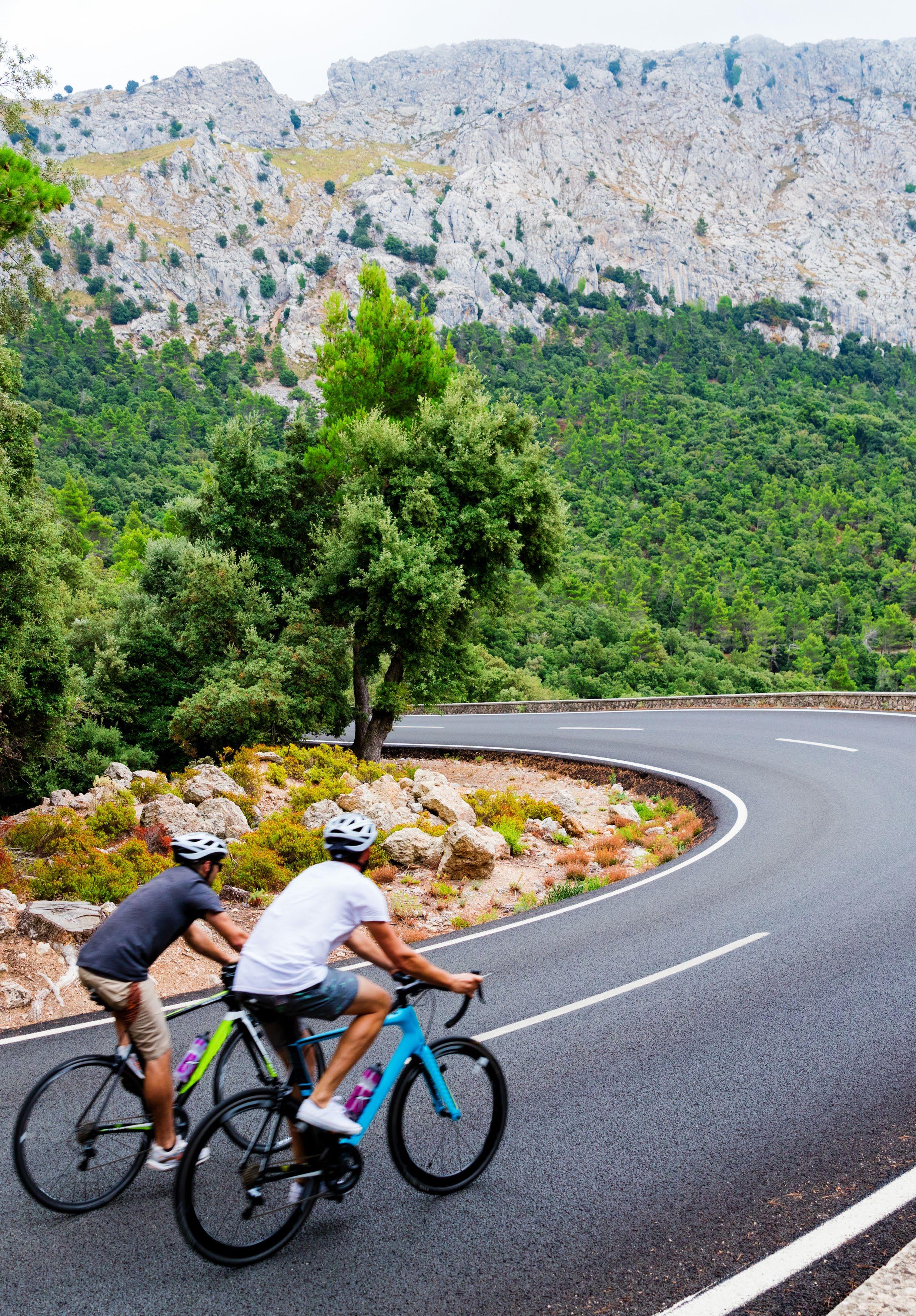

CYCLE TOURING in Spain

INTRODUCTION
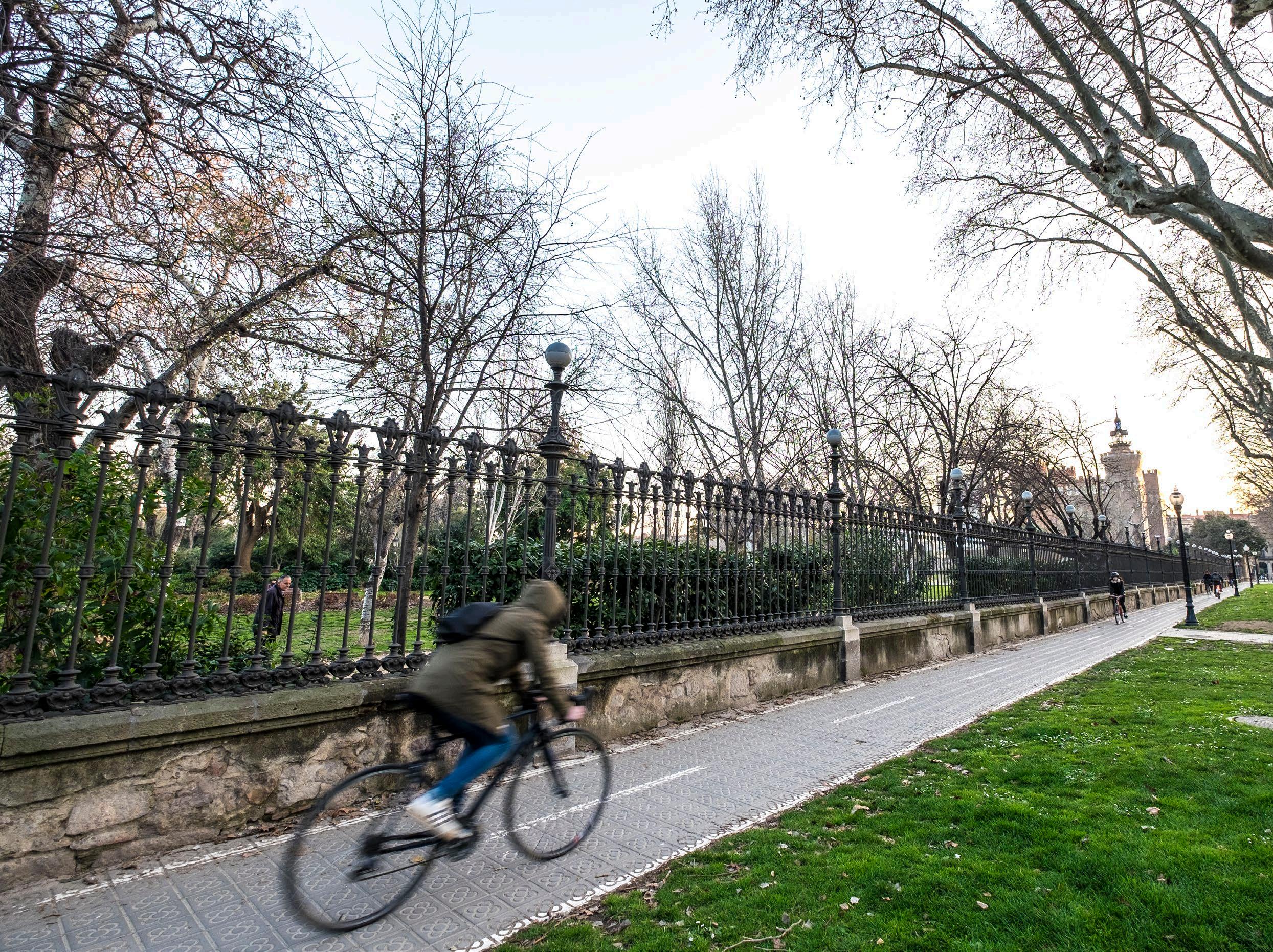
On a road, a mountain, a gravel or a city bike — you choose.
If you love cycling, then Spain is the place for you. You'll have the chance to explore beautiful landscapes, towns, villages and cities any way you like: taking short or long routes, on your own bike or on a hired one.
Spain's geographic diversity and its excellent climate mean you can enjoy cycle touring at any time of year, and whatever your level of physical fitness.
There are many spaces specially adapted for cyclists, perfectly signposted roads, bike lanes and themed routes. What's
more, along the way you'll find all types of accommodation, specialist companies and hiring options.
You can cycle around cities safely and comfortably, or along trails in the heart of nature. When you take any of the Greenway cycle trails you'll discover exciting itineraries that follow the routes of disused railway lines. You'll even find routes with disabled access.
If you like a challenge, why not try one of the great routes, some of which are known worldwide, such as the Way of Saint James.
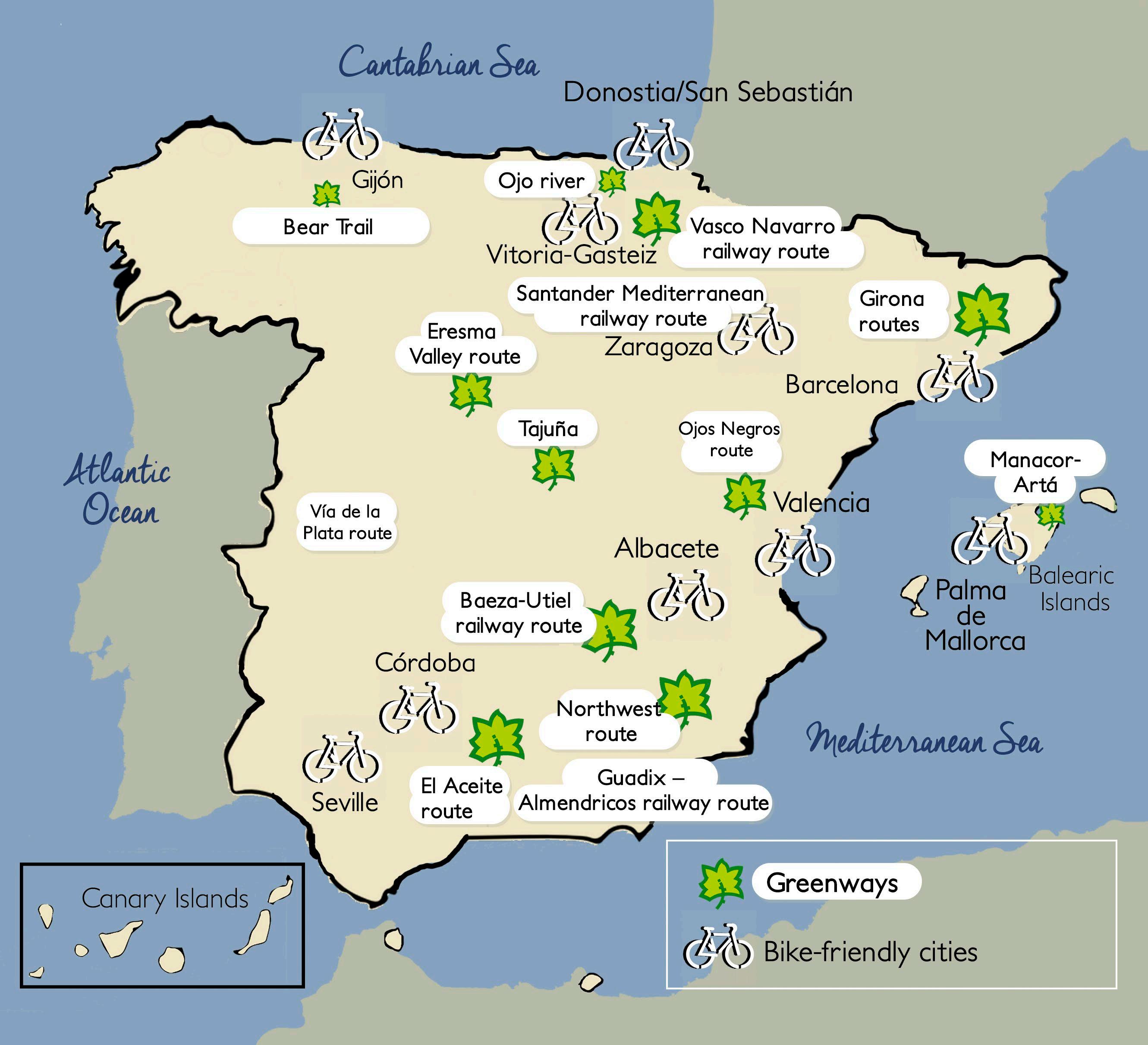
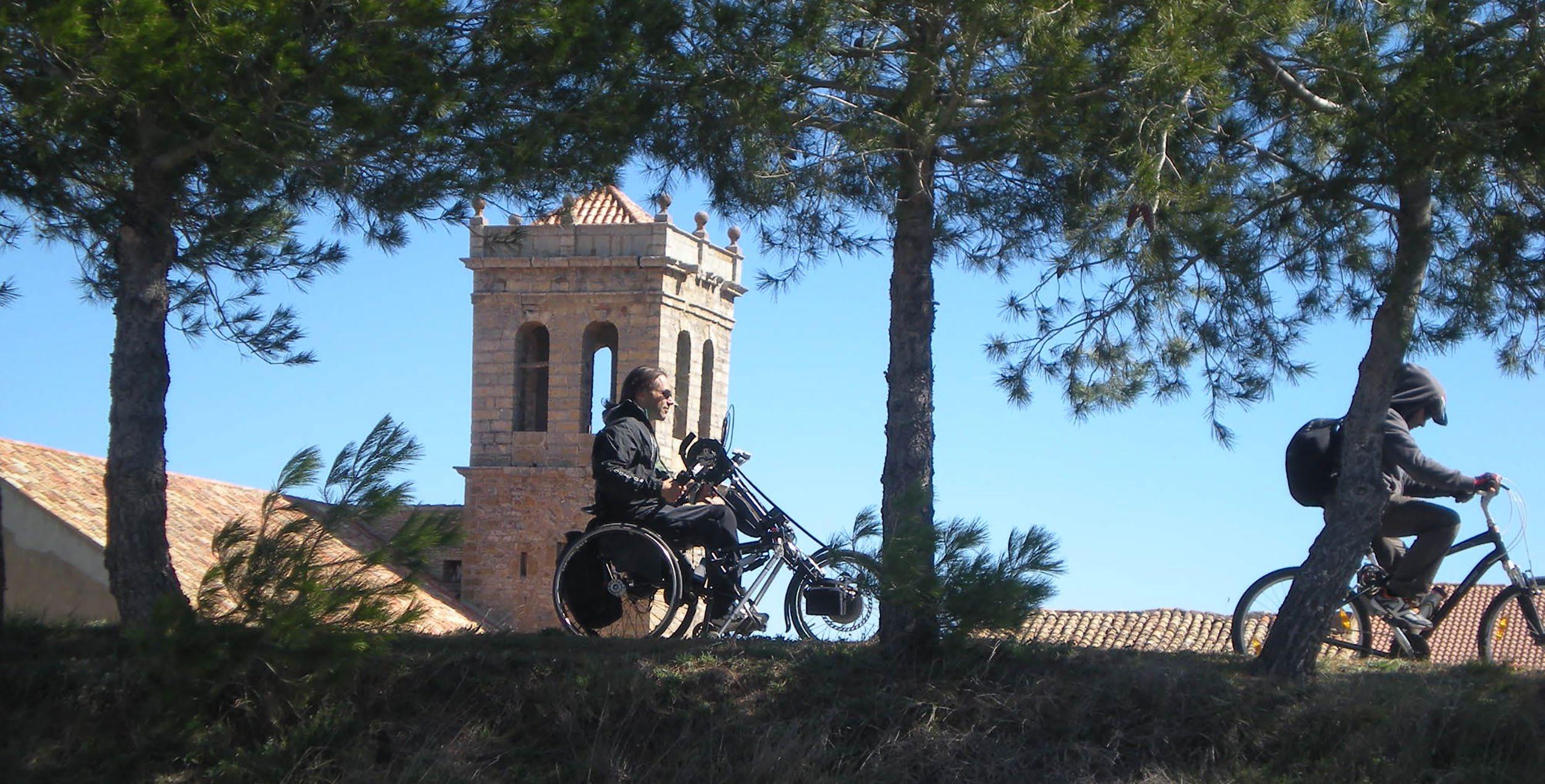
GREENWAY CYCLING ROUTES
Pedal comfortably along old railways lines that have been converted into cycle-touring routes. This is a chance to discover many different places, to cycle through beautiful natural settings, and to travel back in time as you visit the remains of our railway past. The slopes are gentle, the curves are open, and there are restored bridges or viaducts to cross the rivers. The Greenway cycling routes are perfect for people of all ages, and many of them guarantee universal accessibility for people with reduced mobility.
You can choose from 138 different itineraries with a total of more than 3,400 km all over Spain. Here we present a selection of 11 Greenway cycling routes. Choose one or find your favourite at:
L www.viasverdes.com
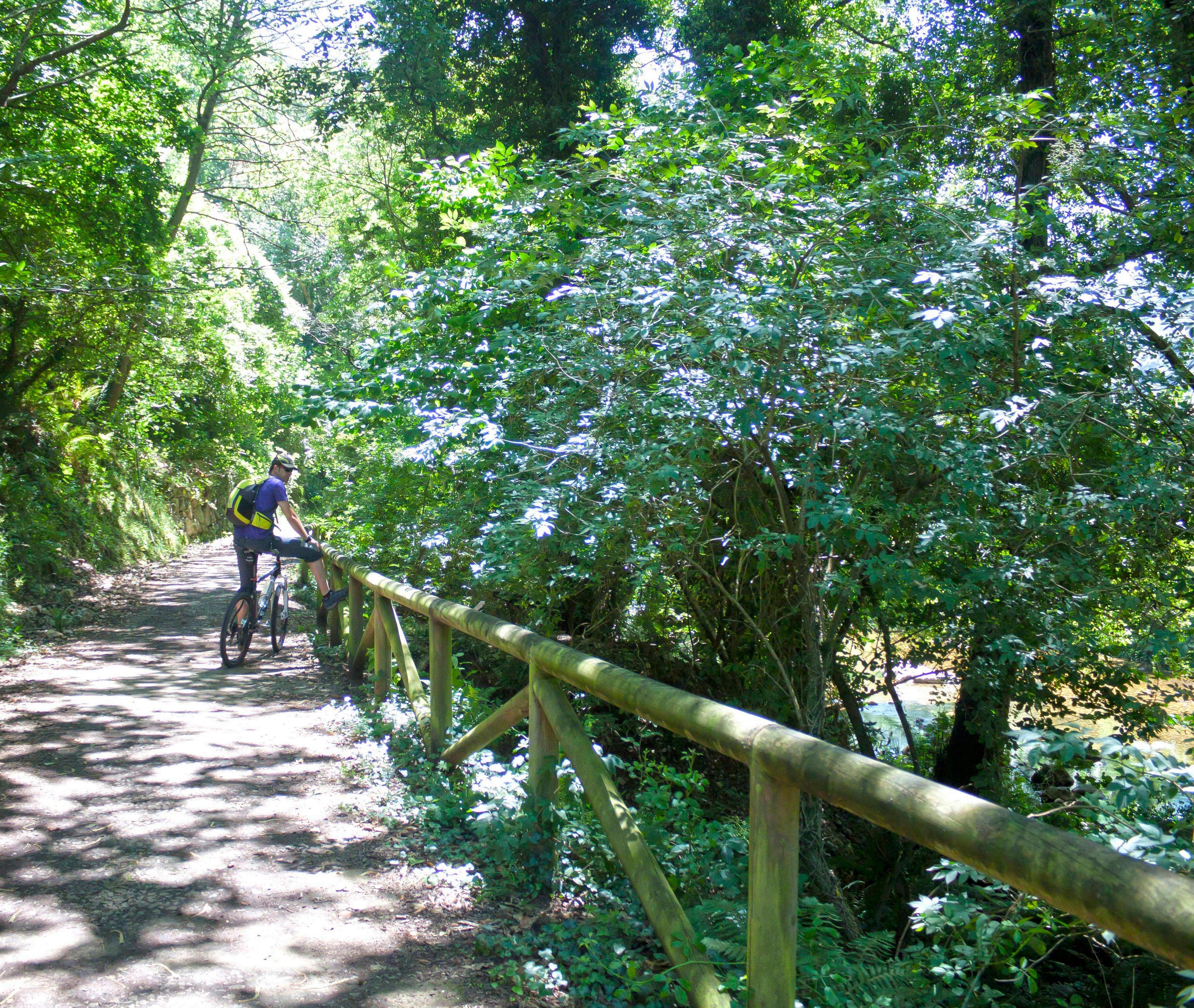
SENDA DEL OSO GREENWAY NATURE TRAIL
Go deep into the heart of the mountains of Asturias on your bike. As you pedal along the Oso Valley, you'll be following the route of an old mining train, and you'll be cycling through incredibly lush vegetation. Your route will take you through green pastures and woodlands, spectacular gorges
and tunnels and across turbulent river rapids. If you're lucky you may catch sight of some protected brown bears in Buyera. Before you reach the end of your route, which is about 36 km long, you can park your bike and take a kayak trip in the Valdemurio reservoir.
GREENWAY CYCLING ROUTE ALONG THE VASCO NAVARRO RAILWAY
This route offers you a succession of different landscapes across plains and mountains, through tunnels and over spectacular viaducts. Take your pick from three exciting independent itineraries and enjoy all the nature and culture you'll find along your way. Section I has a length of around 48 km and starts at the beautiful Navarre town of Estella-Lizarra, part of Camino de Santiago, and ends at the Santo Toribio shrine, in the province of ArabaÁlava. Immerse yourself in its aweinspiring mountain landscape, including the impressive Arquijas cliff and its spectacular viaduct over the Ega River.
Section II is almost 28 km between the Laminoria tunnel and the province’s capital city, Vitoria Gasteiz, through the Alava Mountain. You will also find a 1.5 km section to the Estíbaliz shrine, a small Romanesque jewel visited by Camino de Santiago pilgrilms. Section III is almost 20 km, between VitoriaGasteiz and Arlabán, on the border with Gipuzkoa, another province in the Basque Country. You will ride through a valley covered in farmland, the Llanada Alavesa.
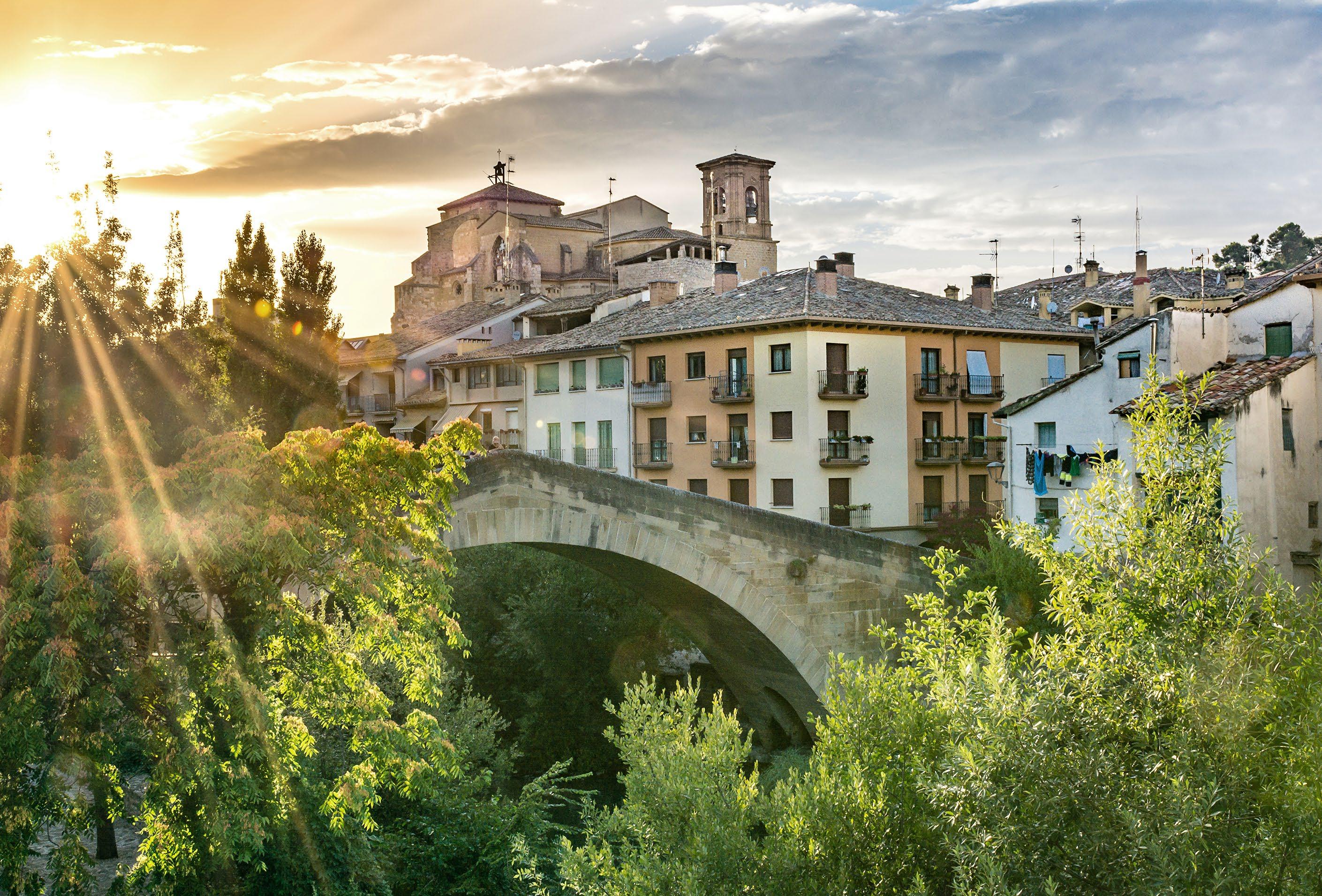
GREENWAY CYCLING ROUTES IN GIRONA
Explore the province of Girona in Catalonia by taking any of the three Greenway cycling routes. From Olot you can start out on the Carrilet I route, with a length of around 54km. The route follows a downwards slope through the woodlands beside the river, against a backdrop of the dormant volcanoes of La Garrotxa, until you reach the city of Girona. Here you can link up with the Carrilet II cycling route that will take you to the Mediterranean beaches of Sant Feliu de Guíxols. Along the almost 40 km of the route you'll be cycling through the heart of the Mediterranean woodland and have the opportunity to discover the outstanding beauty of the Gironès and Baix Empordà regions. Another interesting itinerary, and only 15 km long, is the one that follows the old iron and coal route: the Greenway del Ferro i del Carbó. You can explore the area's industrial past while you enjoy the natural surroundings.
OJA RIVER GREENWAY NATURE TRAIL
Cycle along the banks of the Oja River from the Ebro to the La Demanda mountains in La Rioja. Along the route you'll see its famous vineyards, climb gentle wooded slopes and follow winding roads through the mountains. Don't miss a stop in the lovely medieval town of Santo Domingo de La Calzada, a stopping place for pilgrims on the Way of Saint James. If cycling almost 30 km doesn't seem a big deal, then carry on along the GR 93 route to San Millán de la Cogolla, another gem on the Way of Saint James.
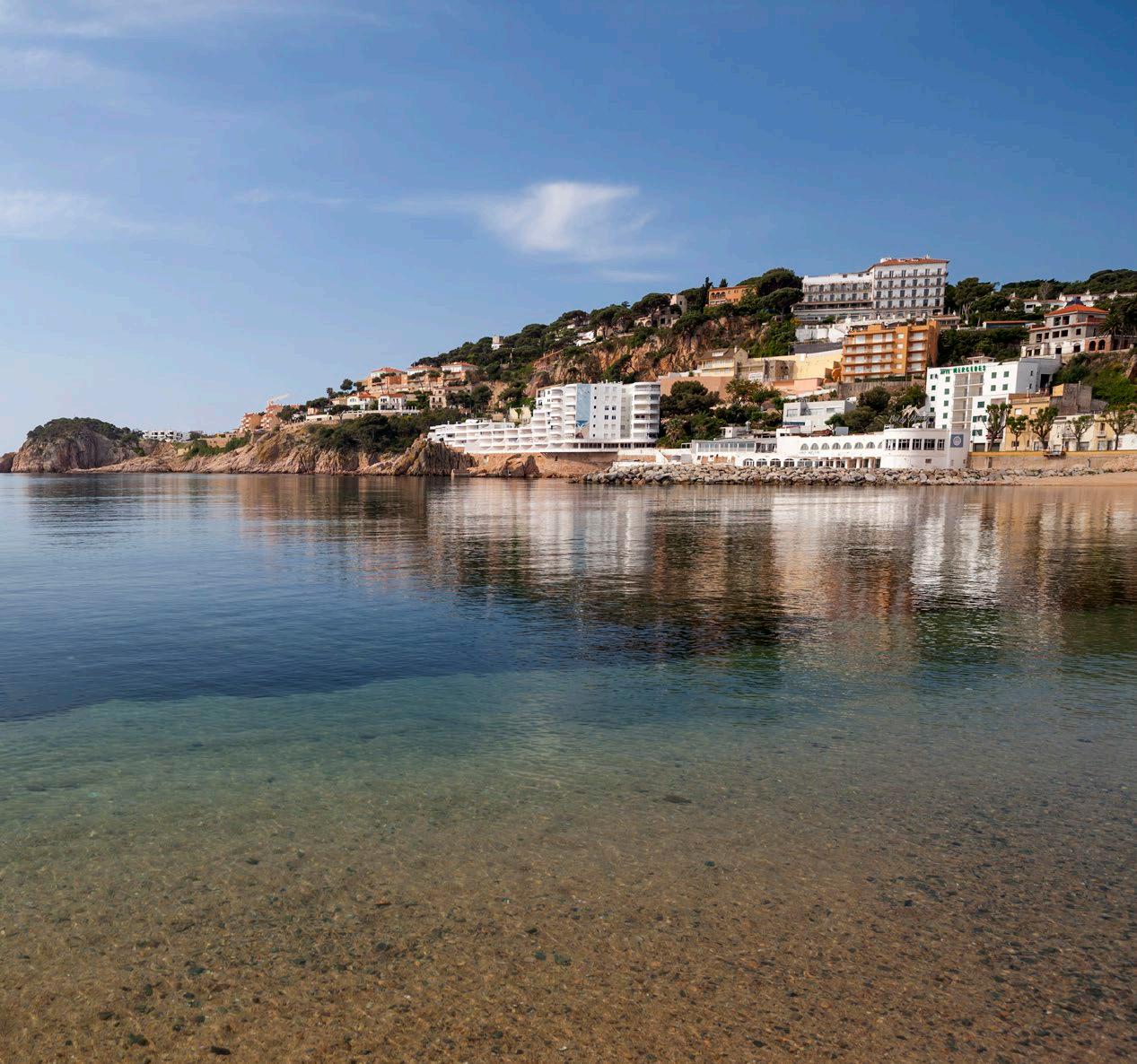
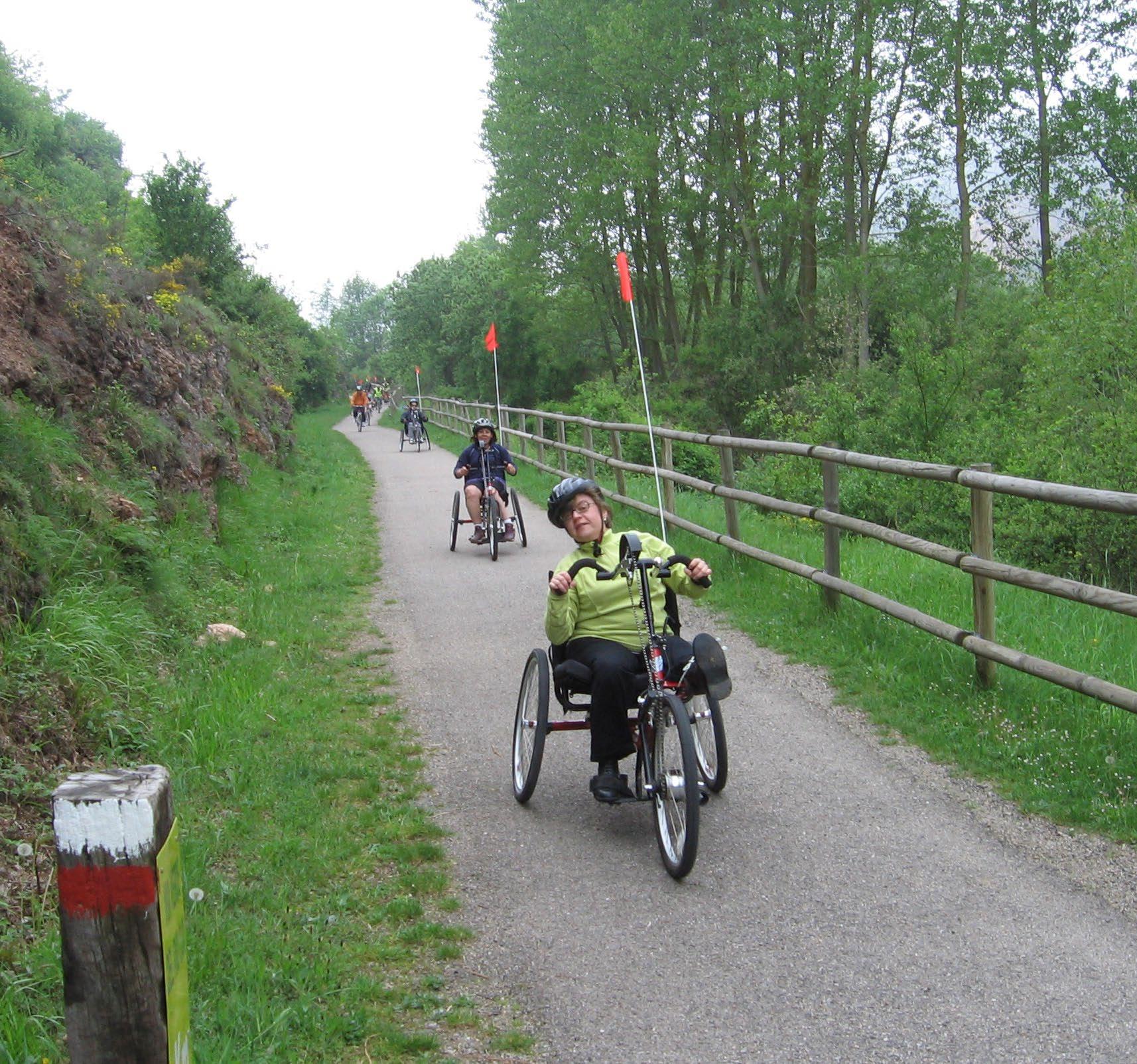
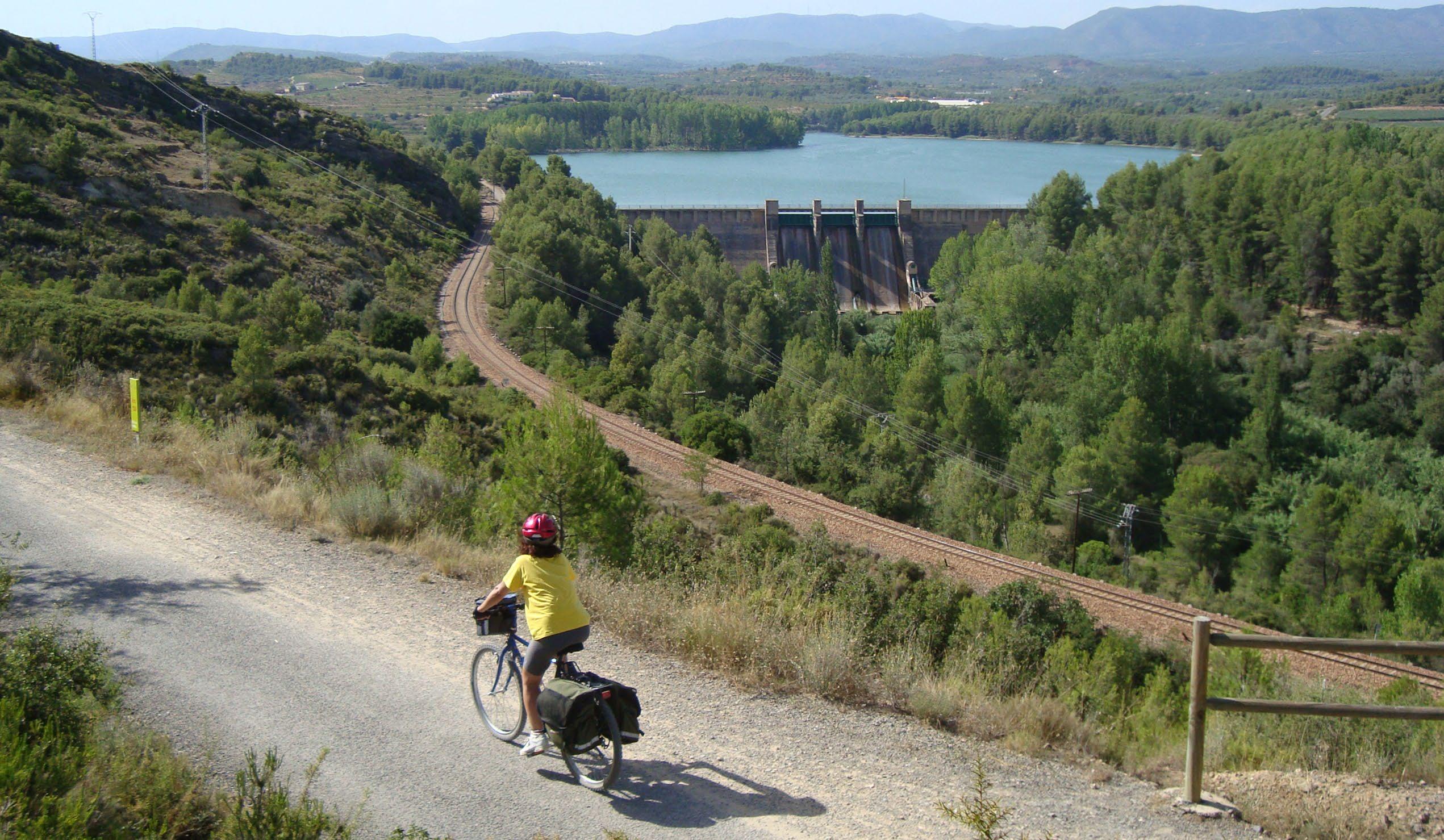
ERESMA VALLEY GREENWAY NATURE TRAIL
If you're looking for a route that's especially rich in culture, a good option is this 73-km itinerary from Segovia to Olmedo, in the province of Valladolid. When you leave the UNESCO World Heritage site of Segovia, you'll find there's still much more to see. Other highlights include the Gothic-style monastery-church of Nuestra Señora de la Soterraña, and the Romanesque shrine of San Miguel de Párraces in Santa María la Real de Nieva. And all this while you cycle through the beautiful natural landscapes of the Eresma Valley with its cereal plantations, holm-oak groves and the woodlands of poplar and pine trees lining the Eresma River.
OJOS NEGRO GREENWAY CYCLING ROUTE
Set yourself the challenge of pedalling more than 180 km from the province of Teruel in Aragon to the fertile agricultural lands of Valencia on the shores of the Mediterranean, famous for their orange groves. On your way you'll see the old stations of the mining railway and spectacular tunnels and gorges spanned by viaducts. You can make a stop on your route and stroll Teruel or the historic centres of Sarrión and La Puebla de Valverde. You'll also coincide with the Route of El Cid, another important cycle-touring itinerary.
TAJUÑA GREENWAY CYCLING ROUTE
Come and enjoy this itinerary that runs alongside the Tajuña River, in the Madrid region and the province of Guadalajara. It's a very easy route to cycle: a red asphalt road leads through a pleasant landscape of river plains for 68 km. You can also reach the starting point by metro to the station of Arganda. Why not take a small detour and visit the historic trains in the Railway Museum in La Poveda. You'll be cycling through farmlands and woodlands and under low bridges. In the summer, before you finish your route, you can take a dip in the municipal swimming pool in Ambite, before riding on to Pozo de Almoguera, in the province of Guadalajara.
BAEZA-UTIEL RAILWAY GREENWAY NATURE TRAIL (SIERRA DE ALCARAZ SECTION)
Before setting out, take a tour of the city of Albacete using the bike lanes to visit its historic monuments. Then you can follow the adventures of Cervantes' character along this road for some 94 km, as it is part of the great Route of Don Quixote in Castile-La Mancha. On the way you'll see the farmlands on the plains of Albacete until you come to the basin of the Jardín River. You'll be surrounded by steep mountain landscapes with an abundance of pine trees and holm oaks. You'll go through 20 tunnels and over several viaducts until you reach the town of Alcaraz, on the border with the province of Jaén. If you want to carry on riding in Jaén, you can cycle another 27 km along the famous Segura Greenway cycling route.
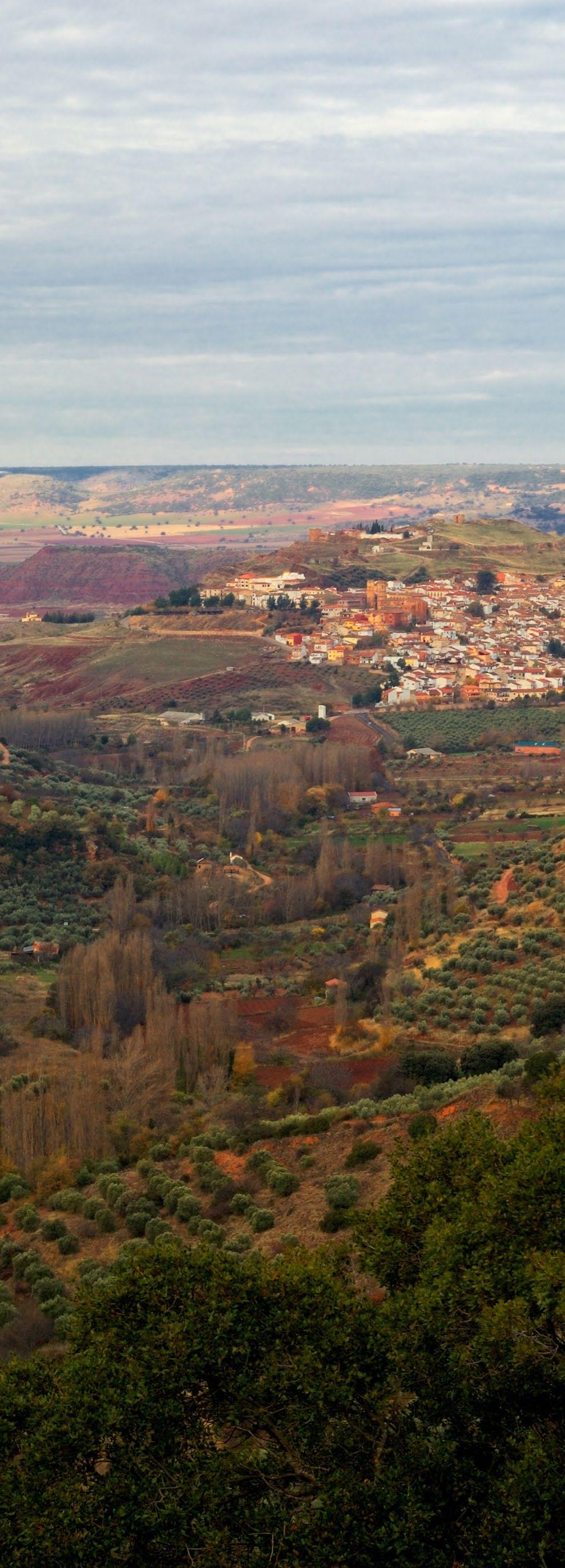
NORTHWEST GREENWAY NATURE TRAIL
You can start this 80 km route after admiring the architectural beauty of the city of Murcia. From the dense pine forests and fertile farmlands along the Segura River and through eerie lunar landscapes and desert areas, the varied landscapes of the Region of Murcia are sure to surprise you. You can also visit the historic towns of Cehegín, Mula and Caravaca de la Cruz, your starting point. If you prefer a more leisurely pace, you can do the route in four stages, and stay overnight in the network of hostels on the Greenway cycling route: los Alverdes, some of which are located in the former stations along the route.
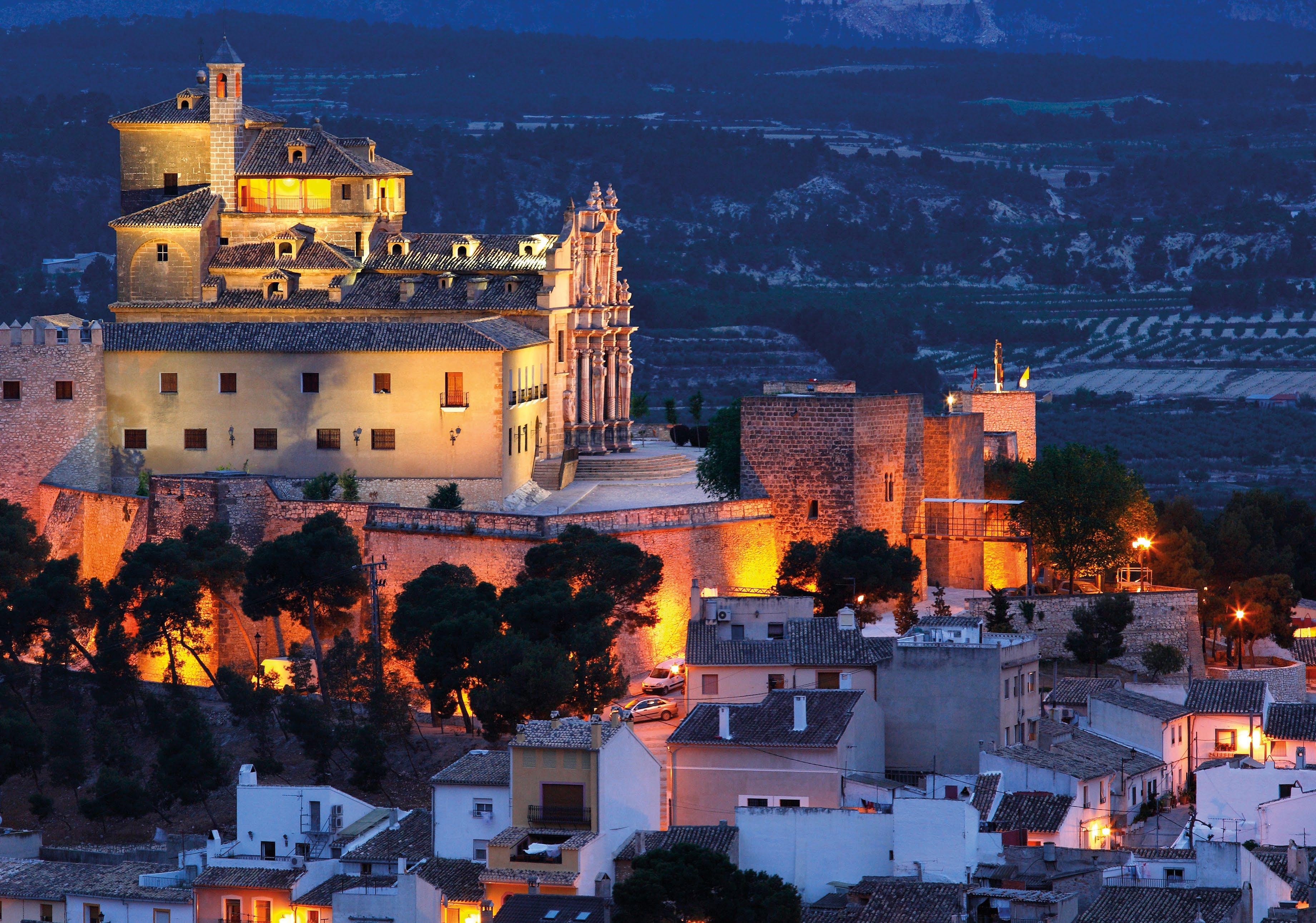
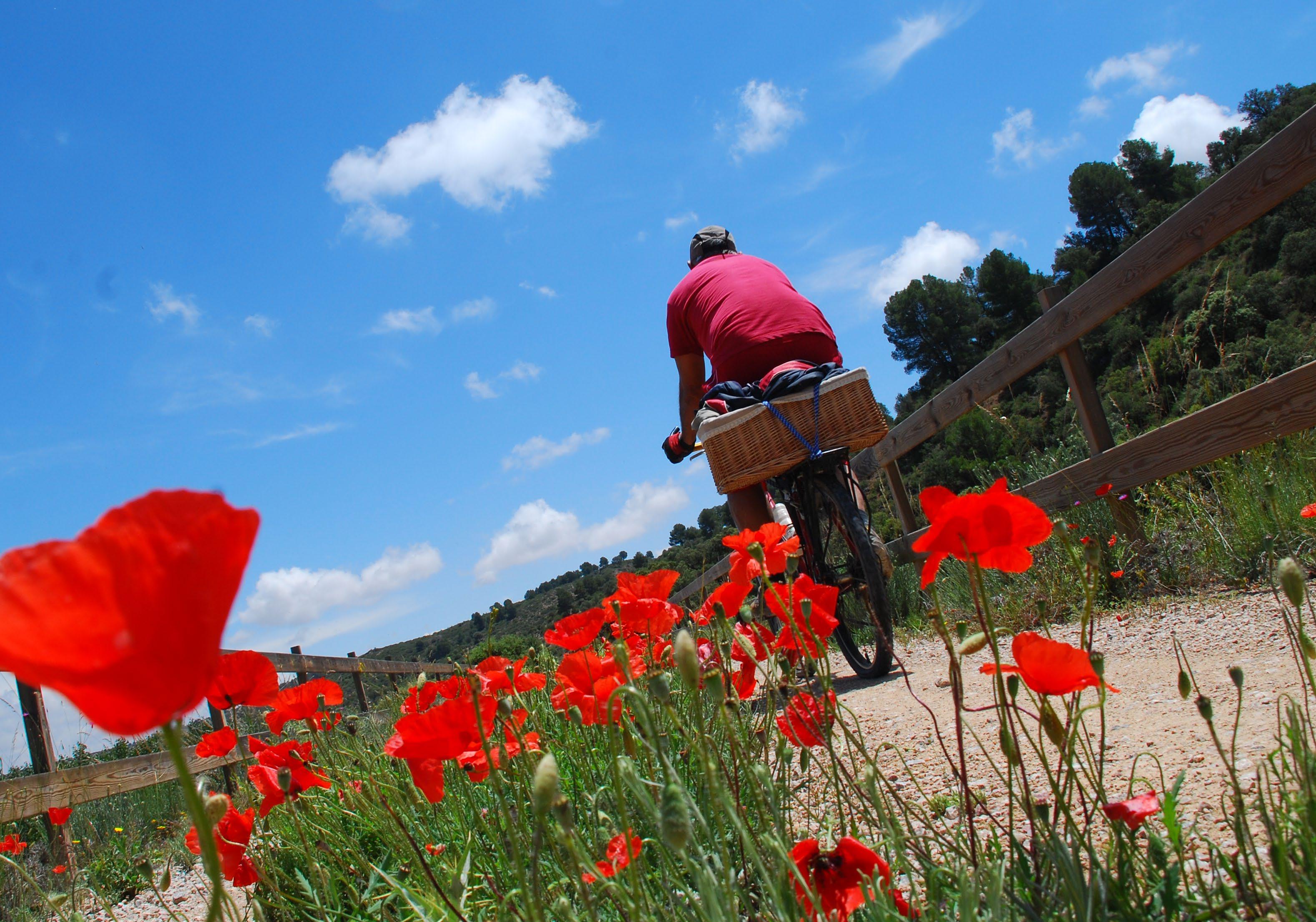 Photo: Fundación de los Ferrocarriles Españoles
SIERRA ALCARAZ ALBACETE
_ CARAVACA DE LA CRUZ MURCIA
Photo: Fundación de los Ferrocarriles Españoles
SIERRA ALCARAZ ALBACETE
_ CARAVACA DE LA CRUZ MURCIA
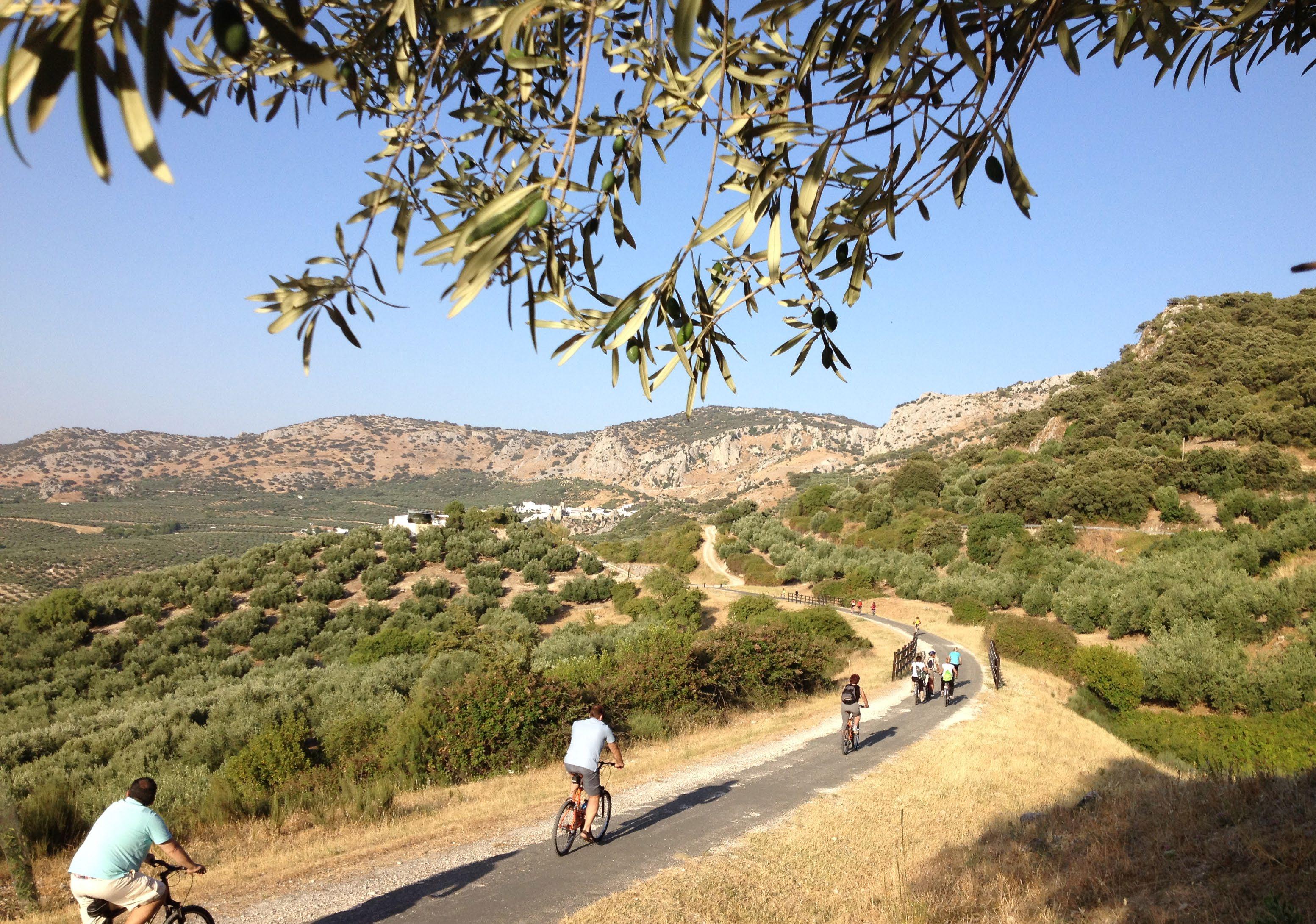
EL ACEITE GREENWAY NATURE TRAIL
Follow the olive oil route through the main producing regions ofJaén and Cordoba in Andalusia. Along the 128 km of this itinerary you'll see endless expanses of olive groves as you follow the route of the Olive Oil Train, with its splendid 19th-century metal viaducts. To learn more about the process of making this "liquid gold", you can visit one of the olive oil presses and take part in a tasting session. Surrender to the wonders of nature: take the Route of the Ancient Olive Trees in Martos, see the birdlife in the Laguna de Salobral and wander along the paths in the Sierras Subbéticas Nature Reserve.
MANACOR-ARTÁ GREENWAY NATURE TRAIL
Discover Mallorca, the largest island in the Balearic archipelago in the Mediterranean Sea. This safe and easy path is about 30 km long and will take you through the attractive landscapes in the east of Mallorca: you'll find extensive farmlands alternating with Mediterranean woodlands on the hills. When you stop at the old stations you'll have the chance to visit some charming rural communities. You'll soon feel the sea breezes from the nearby coast. Halfway along your route in Son Servera, take the bike lane down to some beautiful beaches with fine sand.
L For all information about these greenway cycling routes and many more: www.viasverdes.com
10 BIKE-FRIENDLY CITIES
Discover the treasures of the city from your bike while you do your bit for the environment. These are the top 10 Spanish cities for cyclists, featuring bike lanes, bike hire, guided visits and even smartphone apps.
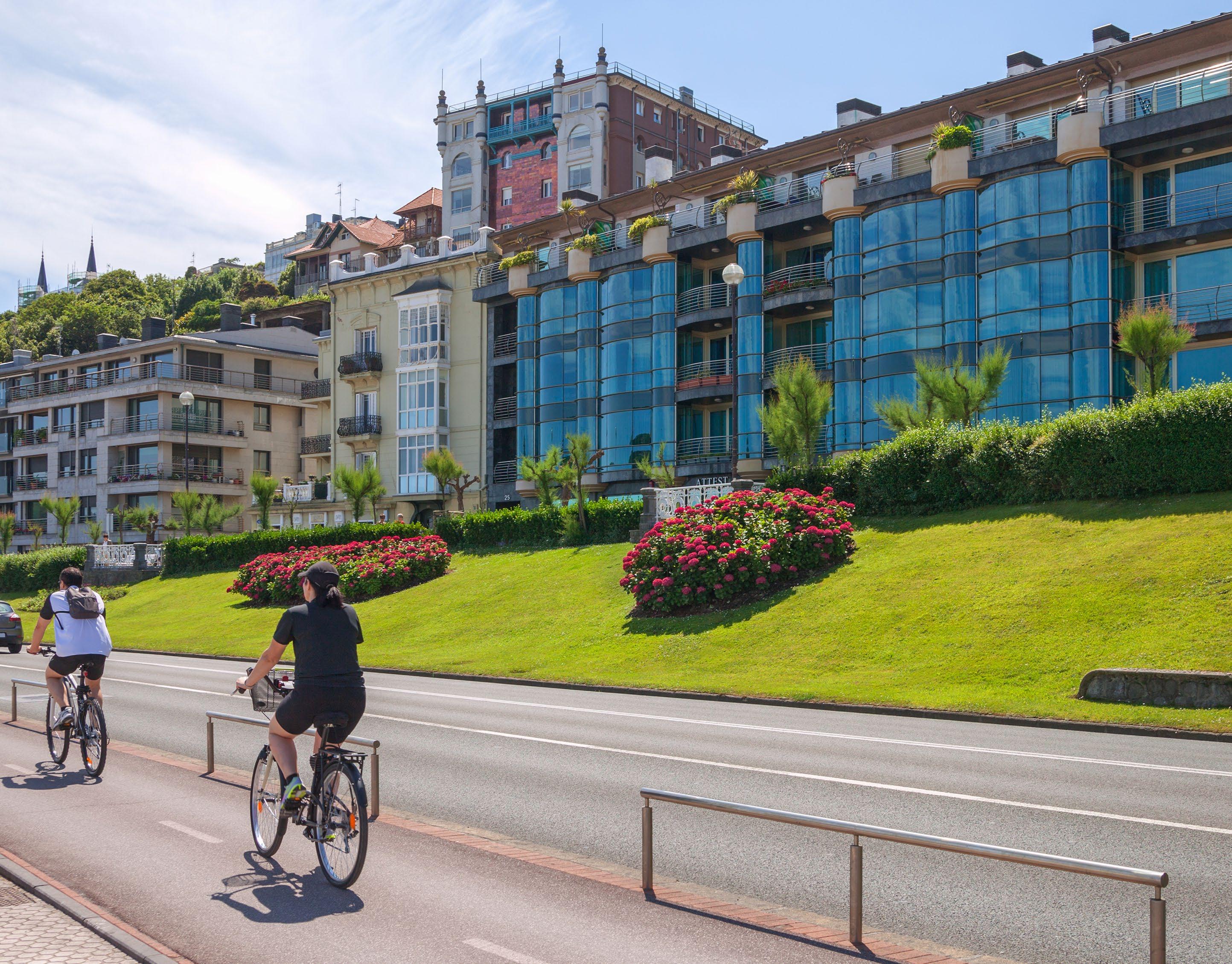
DONOSTIA/SAN SEBASTIÁN
Here you'll find almost 80 km of bike lanes (locally known as bidegorris) to help you explore the capital of Gipuzkoa.
You'll be captivated by the vision of its white sandy beaches like La Concha, one of the loveliest city beaches in Europe. After indulging in the pleasure of cycling along its beautiful seafront promenade, with its views of the bay lapped by the Cantabrian Sea, you can then head for the centre. Following the bidegorris you can move around everywhere in the city in complete safety with one great advantage: it's all practically flat.
Go at your own pace or follow one of the recommended urban routes, with moderate difficulty.
If you're travelling with children, you'll always be within reach of public parks where you can rest.
One good option is to sign up for a guided tour. An expert will take you around the most emblematic sites, you'll be able to try the famous pintxos and you'll be treated to all the best views. If you want to make it even easier, choose a tour on an electric bike.
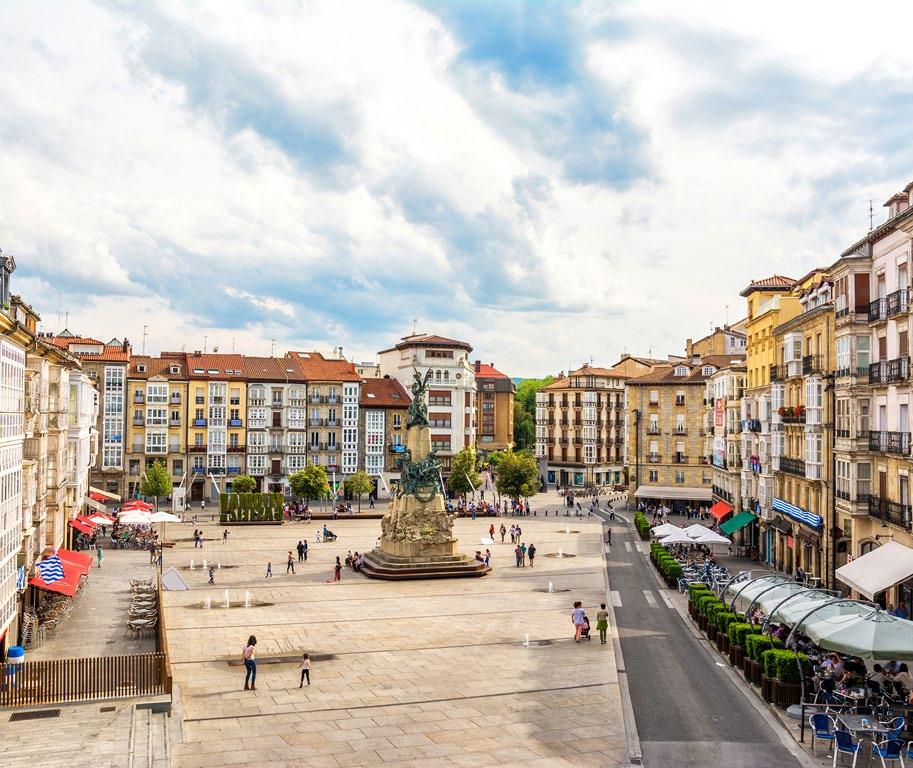
VITORIA-GASTEIZ
Explore this Basque city by bike, with its mediaeval constructions, Renaissance mansions and its extensive green areas. With the exception of the historic centre, located on a hill, the terrain is flat.
You can cycle safely in the centre using their network of bike lanes and explore the surrounding areas following the cycle touring itineraries. You'll find beautiful natural landscapes like the parks of Salburua and Zabalgana, and the Armentia forest: the paths running through them will take you past lakes, wetlands, pastures and gentle hills. If you want to take a tour of all the parks around the city, head for the Anillo Verde, or "green ring". You can do it with the whole family, as the difficulty level is average-low. And remember that Vitoria-Gasteiz is the starting point for the Greenway cycling route along the Vasco Navarro railway.
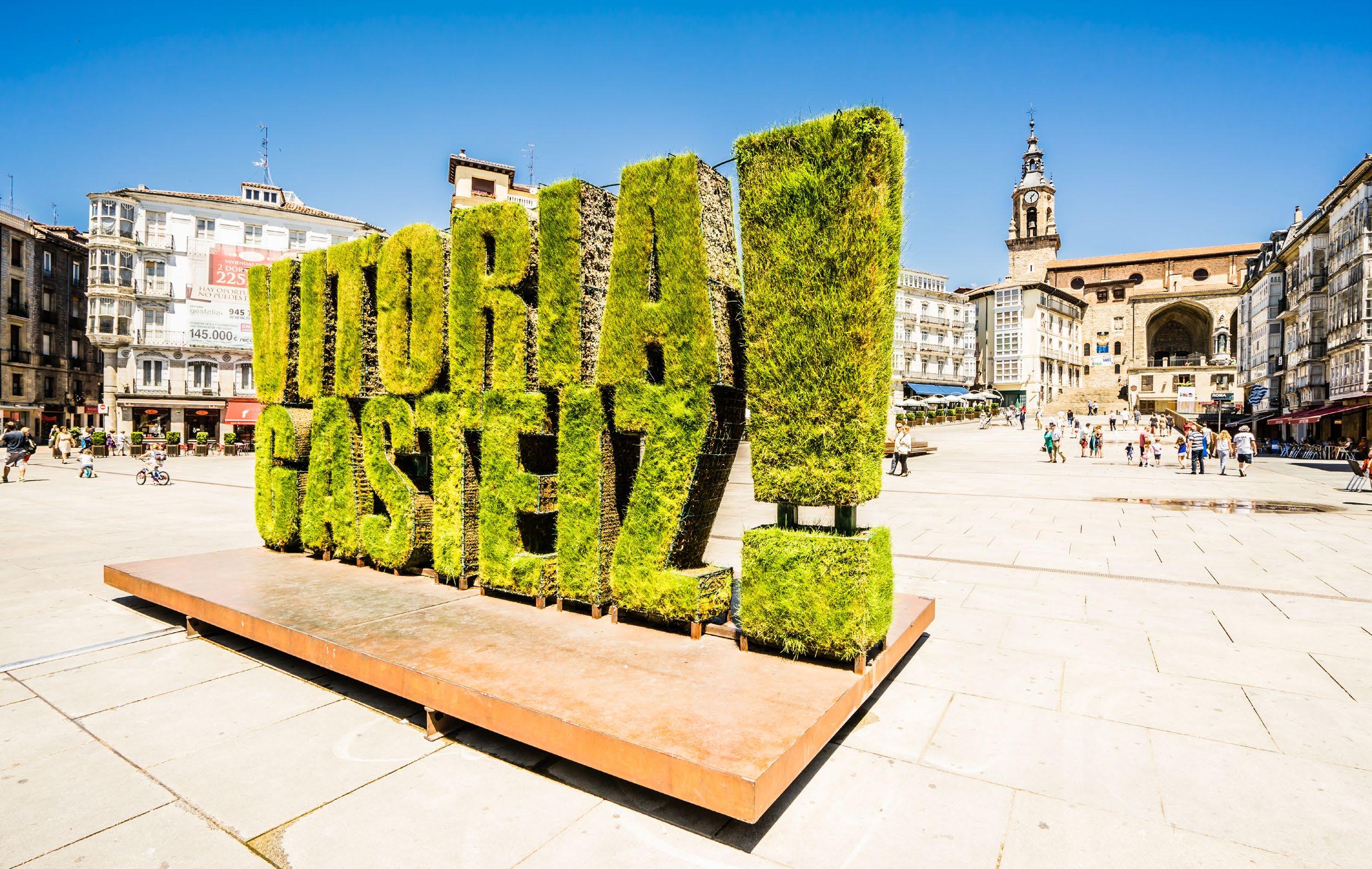
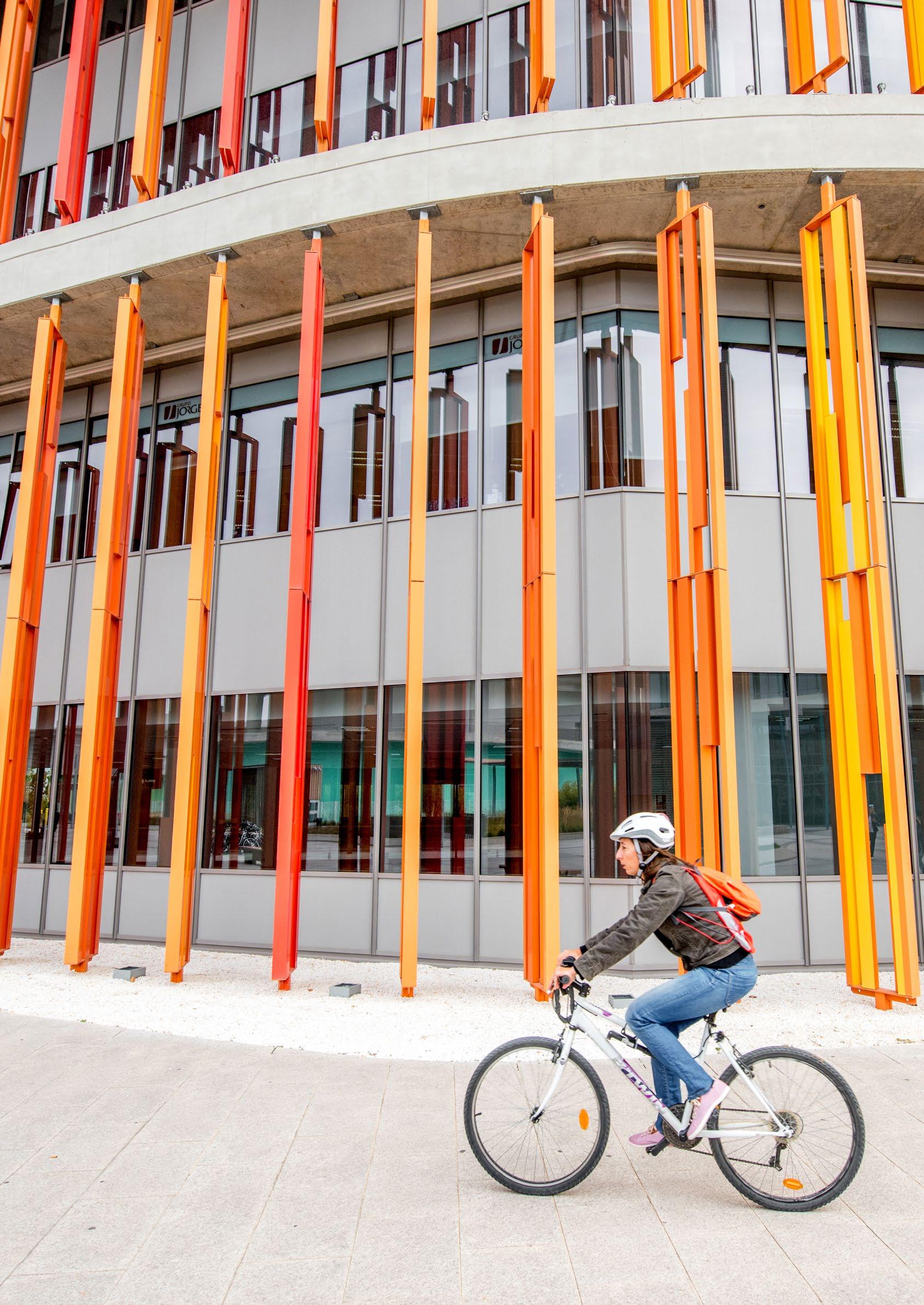
ZARAGOZA
Cycle around the paths on the banks of the Ebro River on the way through the city, as you visit some of its most characteristic monuments: the bridges, the imposing basilica of Nuestra Señora del Pilar and the Palace of La Aljafería To explore the historic centre, take the bike lane that links the squares of Plaza de San Francisco and Plaza España, where you can park and set out on foot. You can also join a guided tour by bike to discover all its gastronomic and cultural riches.
If you don't just want to explore the urban landscapes but also the green areas, there are several itineraries to choose from: you can follow the Anillo Verde or take a tour of the Water Park.
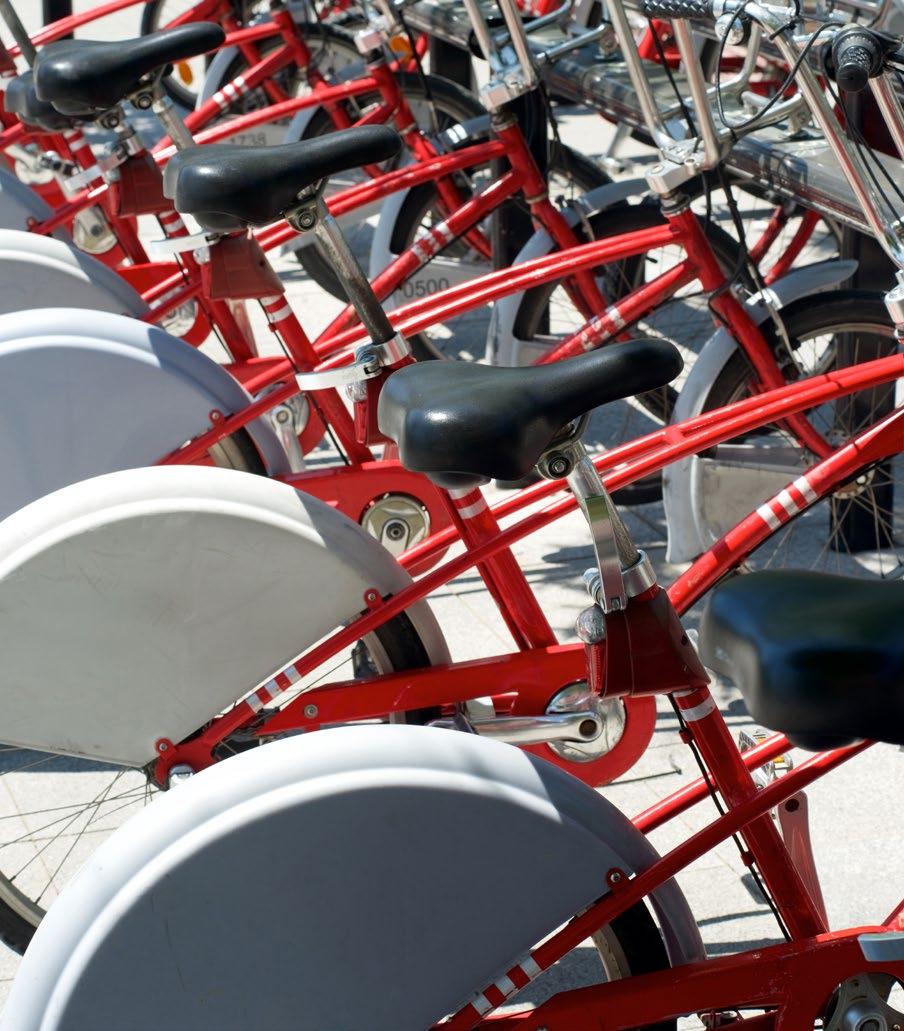
Would you like to go on a longer route and discover the countryside around Zaragoza by following rural trails on a mountain bike? There are also a number of circular routes available.
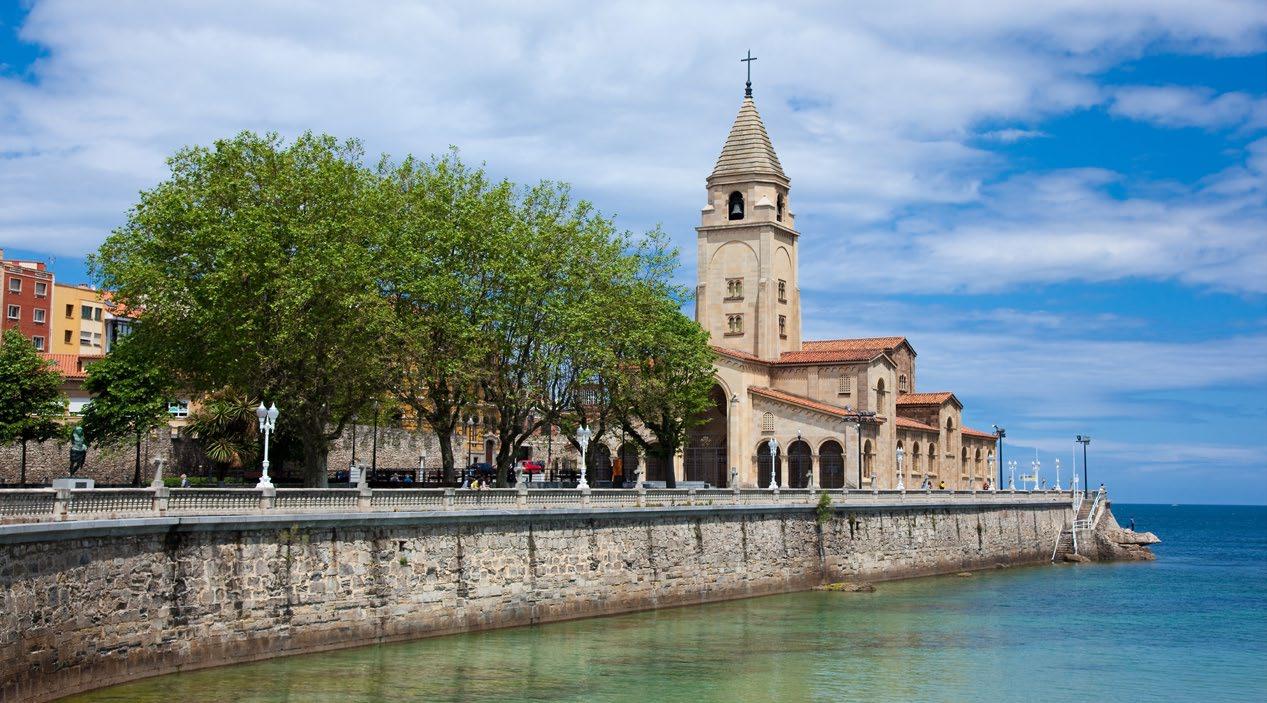
GIJÓN
Enjoy this city in Asturias on two wheels: you can pedal around the bike lanes while you look out over the Cantabrian Sea, or breathe in the fresh air along its promenades and wooded areas. Other options include visits to a number of interesting places like the Asturias Railway Museum, the Aquarium and the Laboral Ciudad de la Cultura monument ensemble.
You'll move almost seamlessly from an urban to a rural area after you gaze at its broad breaches from the promenade. You'll find green routes shared with pedestrians leading into the heart of nature. You can choose from eight different routes: you'll cycle through a landscape of pastures with cattle grazing and past spectacular cliffs. This area is extremely beautiful, with its large houses, typical "hórreos" (picturesque granaries, which are raised from the ground) and traditional washing places. You can even follow the route of the old mining railway when you set out on the La Camocha Greenway cycling route. You're guaranteed to learn a lot: the signposting of these routes includes interesting information on the local culture, traditions and flora and fauna.
ALBACETE
The city of Albacete in Castile-La Mancha awaits you with its mediaeval street layout, and emblematic buildings like the Knife Museum. If you want to cycle through natural landscapes, then head for the Fiesta del Árbol Park, the green lung of the city. From there you can continue along the route of the María Cristina Canal: you'll find a wide flat path that's perfect for cycling with the whole family. After reaching a recreational area you can choose between different itineraries. You can even continue on along the Greenway cycling route that goes to the town of Alcaraz, around 80 km from Albacete.
If you want to immerse yourself in nature and enjoy the sight of plains, steep mountain ranges and fastflowing rivers, then choose any of the cycle-touring routes that go through the nearby areas.
SEVILLE
The capital of Andalusia is perfect for cycling, as it has a sunny climate, short distances and a flat terrain. What's more, it has an extensive network of bike lanes protected from the traffic.
From your bike you can enjoy the architectural wonders of the historic quarter, some of which have been declared a UNESCO World Heritage site, such as the cathedral and Real Alcázar Palace, with fine examples of Almohad art.
When you are ready to take refuge in the shade you can cycle along the treelined alleys in the María Luisa Park, admire the vegetation and discover the spectacular Plaza de España. From here you can continue along the bike lane until you reach the banks of the Guadalquivir River. If you follow the river you'll be guaranteed a pleasant bike ride with the opportunity to discover more monuments and green areas, like the Alamillo Park on the Island of La Cartuja
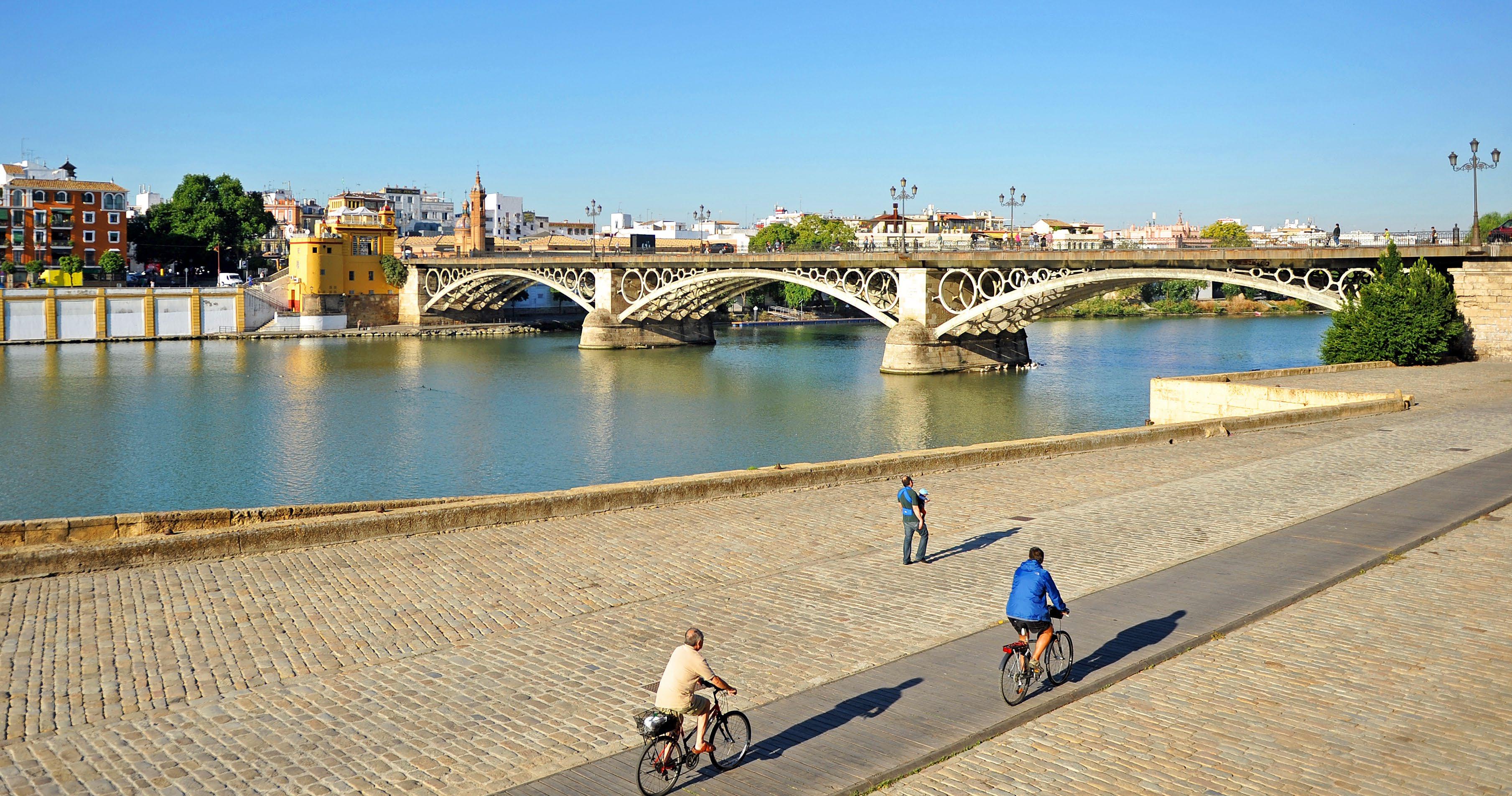
BARCELONA
Come and tour this town with its exceptional climate on your bike. It has over 240 km of bike lanes with different itineraries to explore all the most emblematic areas, such as the Born Quarter, the Gothic Quarter and the beachfront promenade. You'll discover the great works of the famous modernist architect Antoni Gaudí, like the Sagrada Familia and Güell Park
If you'd like to go directly to see the best spots in the city, sign up for a guided visit.
A good way to see excellent panoramic views of the town is to follow the classic route of the Water Road: this path is exclusively for use by pedestrians and cyclists, and runs around the northern part of the city. You can even cycle it by night and admire the city lights. Your starting point is at the foot of Mount Tibidabo.
VALENCIA
Cycling around this Mediterranean capital is particularly easy: the terrain is flat and the climate is very pleasant at any time of the year. You can use the extensive network of bike lanes to tour the centre. What's more, there's a cycle ring designed exclusively for bicycles: you can cycle around the city and link up with the lanes that go towards the centre.
If you prefer to cycle in green areas, a good option is the Turia Garden, an extensive natural city park that will take
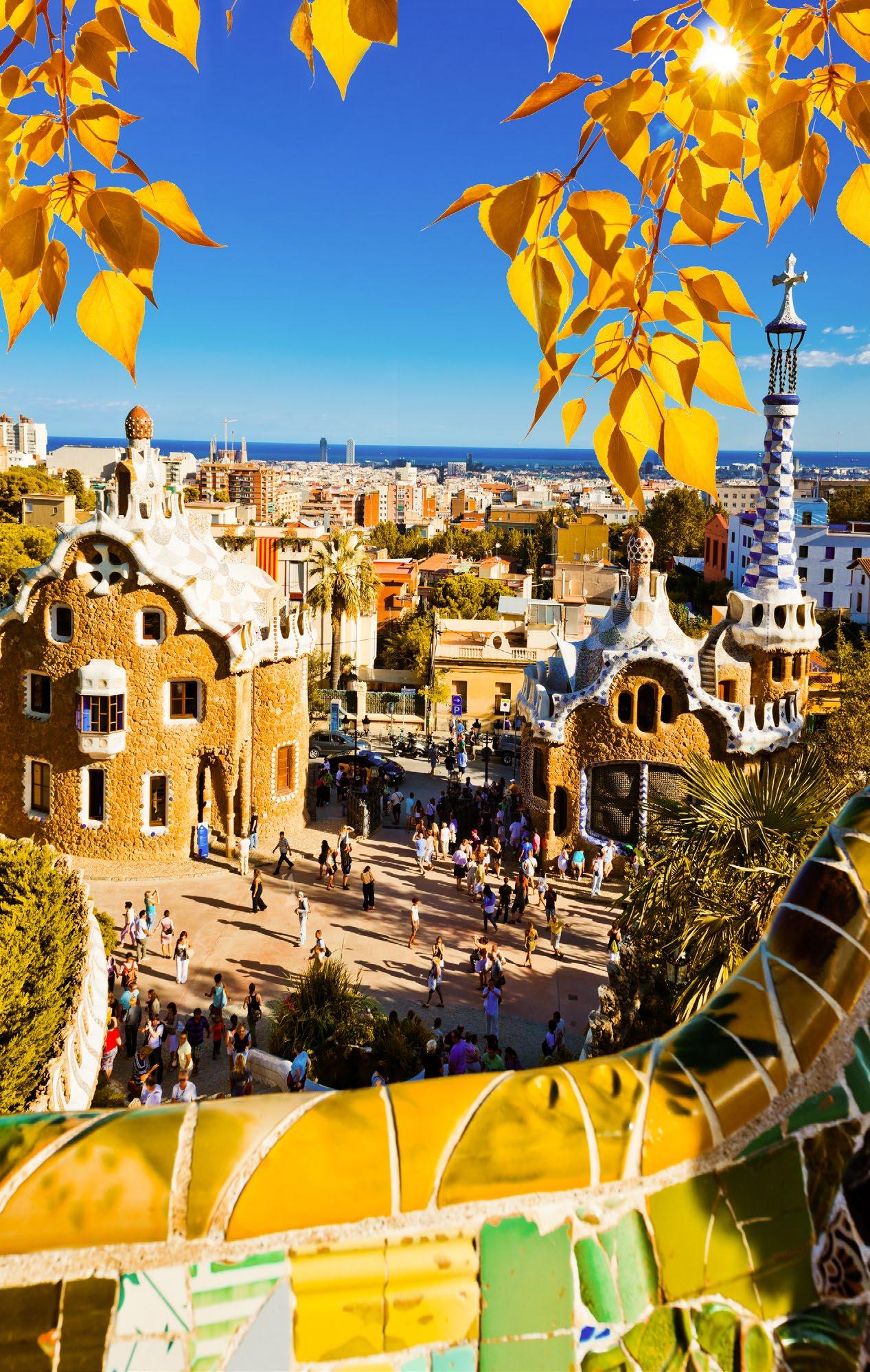
you from the City of Arts and Sciences to the Bioparc along the old riverbed. When you're ready to move away from the city, head for the Turia River Park and take a rest in the heart of nature.
To travel along the coast the best idea is to start out at the port and then head north: you'll go past some beautiful beaches and you're sure to be tempted to stop at one of the seafront restaurants and enjoy a delicious paella.
PALMA DE MALLORCA
You can reach all corners of this lovely island city by bike. It takes a little over half an hour to go from one end to the other, and it has a beautiful old quarter overlooking the Mediterranean Sea. You can ride along the bike lanes and through a peaceful one-way system of lanes.
Another good idea is to cycle along the seafront promenade for a privileged view of the cathedral, known as the Seu de Mallorca, the Almudaina Palace and La Lonja, along with the boats moored in the port. You can stop and rest on its beaches.
And if you feel like leaving the city, there are lovely places you can reach by bike all over the island.
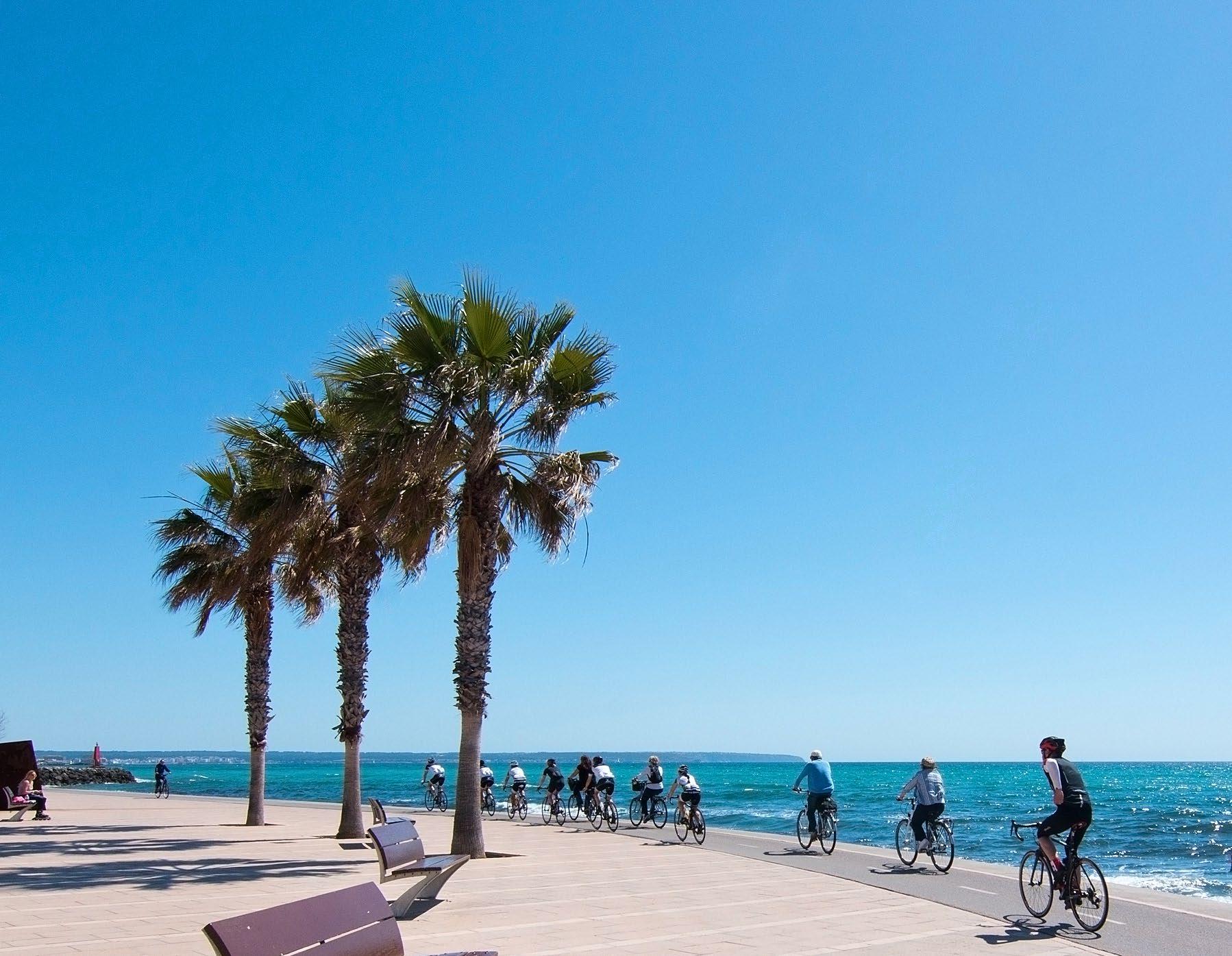
CORDOBA
Discover this ancient city and UNESCO World Heritage site on your bike. As you pedal along the bike lanes you'll come across genuine architectural treasures such as the spectacular MosqueCathedral
You can follow any of the themed routes suggested by the town council in their "Cordoba by bike" programme. Several of them go past the most emblematic monuments, squares and bridges. Others will take you through gardens and parks or along the banks of the Guadalquivir River.
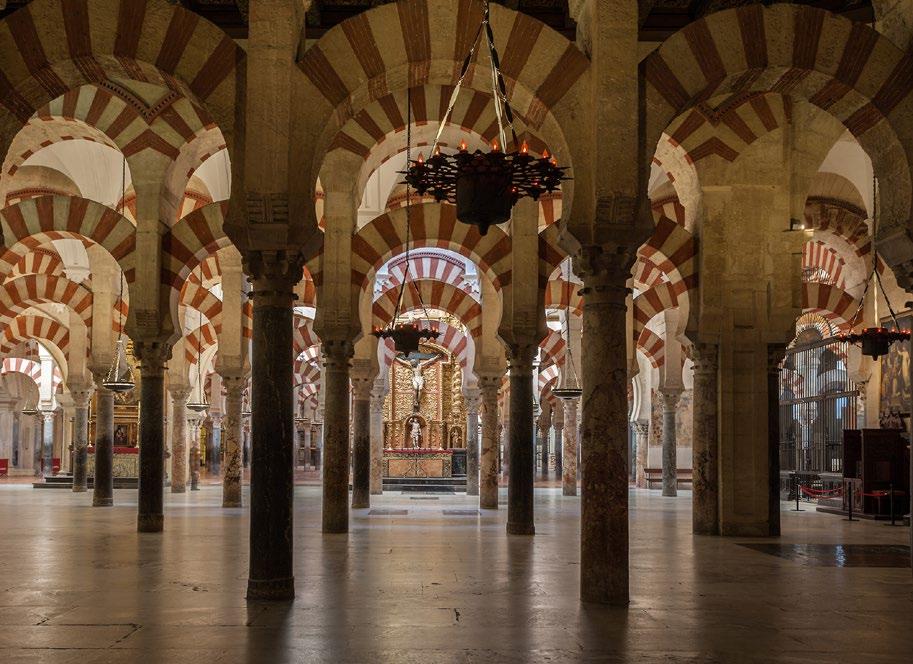
If you want to explore nature outside the centre on an MTB or gravel bike, there are more itineraries available: this is the best way to explore forests, wooded pastures and farmlands, for example, along the La Campiña Greenway Nature Trail.
MEZQUITA DE CÓRDOBAGREAT ROUTES FOR ENJOYING CULTURE AND NATURE
If you like cycling excursions that last several days, there are many more routes to choose from in Spain.
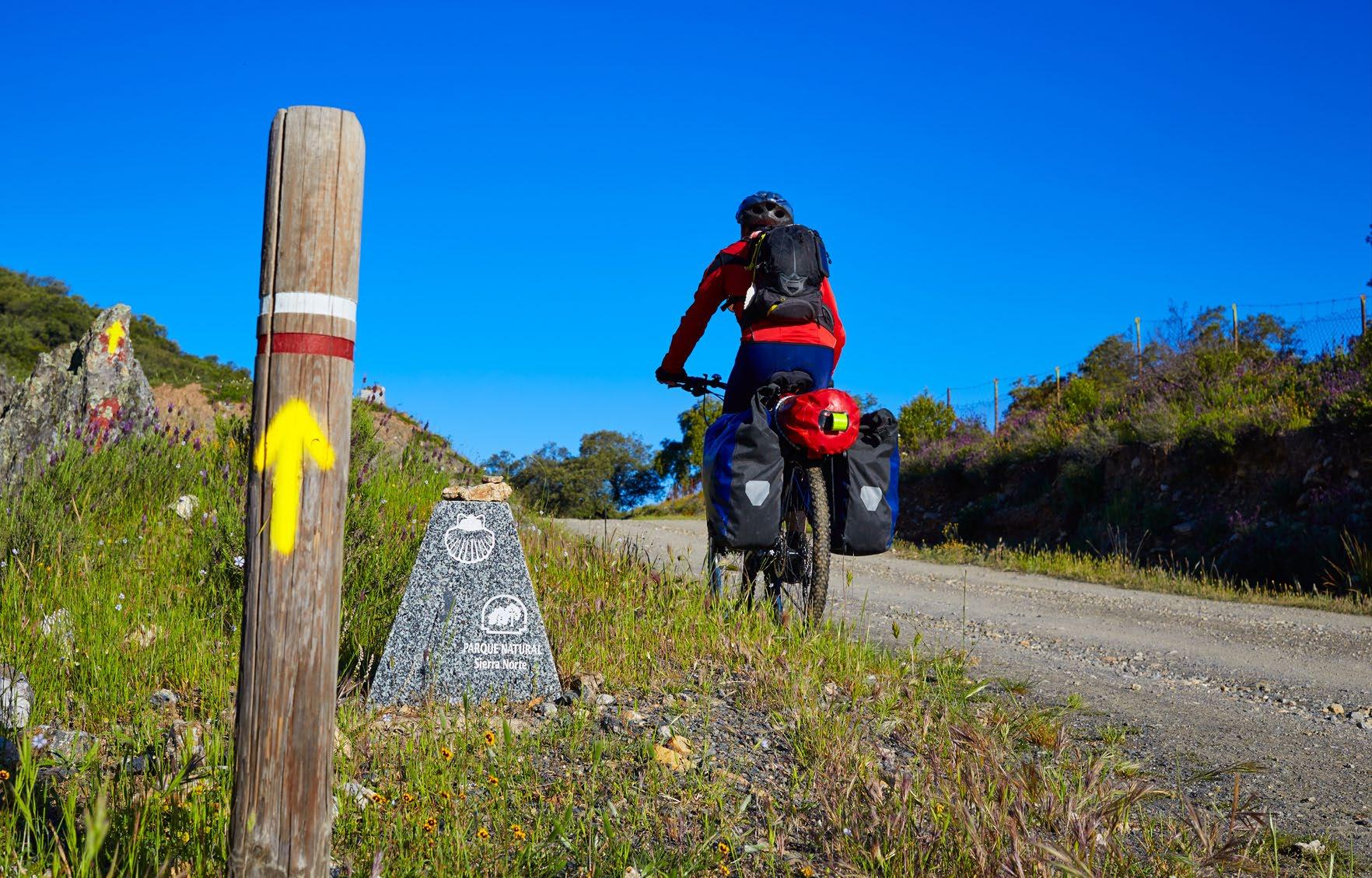
THE WAY OF SAINT JAMES
Come and enjoy a unique experience: follow the Way of Saint James, one of the loveliest routes there is. You'll bike through spectacular landscapes while you discover its extraordinary cultural riches. On your way you'll find a multitude of points of interest: religious buildings in different architectural styles, mediaeval bridges, and even archaeological sites.
You decide your itinerary: there are several options you can choose from to reach your ultimate goal, the Cathedral of Santiago de Compostela in A Coruña (Galicia). The most popular route and a favourite among cyclists is known as the French Way. This is the one cyclists tend to prefer, as it's perfectly signposted, and you can cycle along it almost all the way without deviating from the original route.
It's also specially equipped to receive people travelling by bike. But if you're planning on staying in hostels, be aware they give priority to pilgrims travelling on foot.
Plan your stages in advance and take it slowly: you'll have almost 800 km ahead of you and a lot to see. If you cycle an average of 50 km a day, you can do the route in two weeks. Avoid the colder rainier months from November to March.
The route travels through the autonomous regions of Aragon, Navarre, La Rioja, Castile-León and Galicia. To restore your strength, make a point of sampling the delicious traditional dishes in each region. When you leave behind the Pyrenean landscapes, you'll find yourself cycling through green pastures, beech forests and farmlands. You'll discover Pamplona, a city with a mediaeval layout and famous for the bull-running festival, the Sanfermines. La Rioja will welcome you with landscapes of vineyards, wineries, monasteries and castles. In San Millán de la Cogolla, visit the monasteries of Yuso and Suso, UNESCO World Heritage Sites, where you'll feel like you've been transported back in time to the Middle Ages.
In Castile-León you'll find numerous treasures like Burgos Cathedral, a Gothic gem of incomparable beauty. Another attractive option is to explore smaller towns like Castrojeriz, Frómista and Sahagún
When you reach your destination, you'll be treated to the spectacular sight of the beautiful Santiago Cathedral, and you're assured a warm welcome from a city that's accustomed to receiving thousands of pilgrims.
SILVER ROUTE
This route is over 800 km long and links Seville in the south with Gijón in the north. There are two types of routes: by road, or a route for mountain bikes. You'll travel through four autonomous regions, each with different landscapes, cultures and gastronomy: Andalusia, Extremadura, Castile-León and Asturias. You'll be following the route used by the Roman troops to march to the northern Iberian Peninsula.
Start your route in Seville, the capital of Andalusia. If you like urban cycling, you can explore its rich cultural heritage by taking any of its bike routes. You can also take a side trip to nearby Carmona and visit its lovely historic centre.
In Extremadura you'll see farmlands, vineyards, wooded pastures and the spectacular Jerte Valley.
You're sure to love Cáceres with its mediaeval centre, and Mérida, with its Roman archaeological site, both designated as UNESCO World Heritage Sites. Treat yourself to some Iberian cured ham from Extremadura, amongst the best in Spain. To relax your muscles, immerse yourself in the Roman spa of Baños de Montemayor. You'll also have the chance to visit two beautiful cities: Plasencia, with its imposing cathedral and numerous mansions, and Trujillo, with its monumental Plaza Mayor square and its castle.
Castile-León awaits you with its delicious roast suckling pig and roast lamb, an excellent way of restoring your strength after cycling through so many spectacular architectural sites like Béjar, Salamanca, Zamora and León. Also, several of the route’s sections take you through the old Vía de la Plata railway, which has been turned into comfortable nature trailsgreenways
In Asturias, you will keep finding architectural jewels, such as the PreRomanesque churches in Oviedo and its surrounding areas, UNESCO World Heritage Sites, located amid spectacular valleys and mountains. When you reach your goal, Gijón, you can reward yourself for your hard work with a swim at the beach or a ride along the seafront promenade while you enjoy the breezes from the Cantabrian Sea. Take a seat at a bar or restaurant and sample some fish or a typical "fabada", a traditional white bean stew, and some traditional Asturian cider. You'll find more information on this route at:
L www.larutaenbici.com
THE TRANSANDALUS
Travel by bike around the eight Andalusian provinces: Seville, Cordoba, Jaén, Granada, Almería, Malaga, Cadiz and Huelva. Are you tough enough to embark on this long circular route around Andalusia on your mountain bike? You're guaranteed to enjoy the region's excellent climate and friendly inhabitants. You'll discover many locations off the traditional beaten tourist track as you explore both the coast and the interior of these provinces.
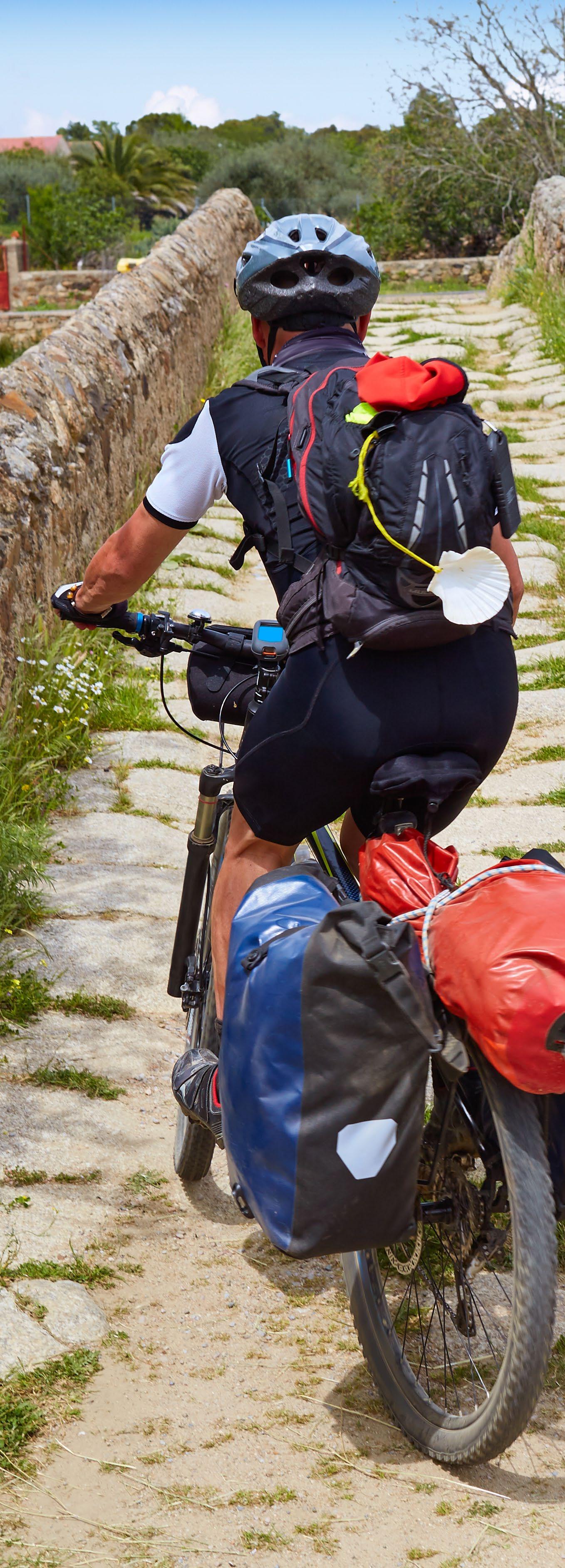
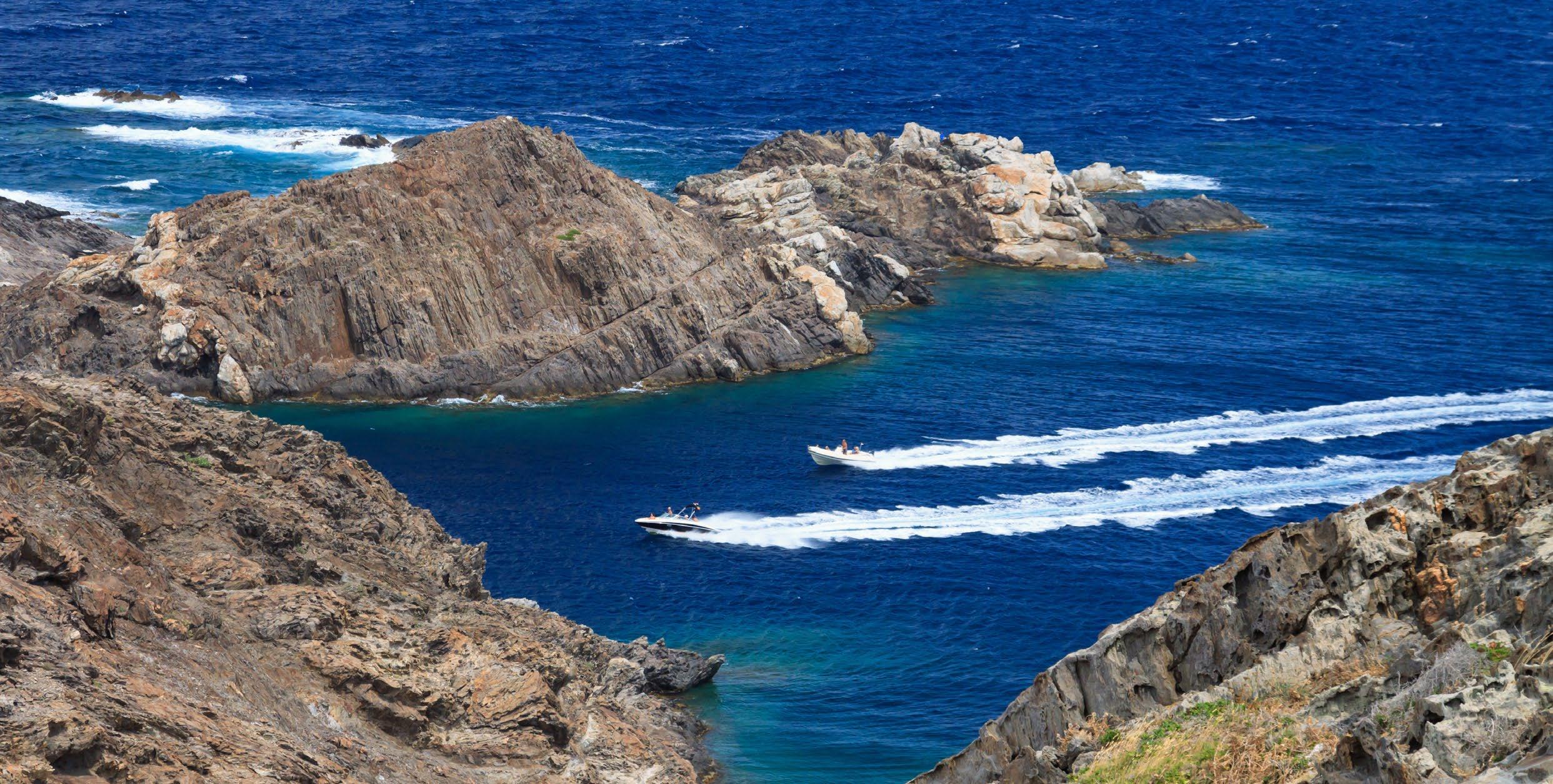
The route is 2,000 km long and some sections coincide with the GR routes or shorter distance trails. 35% of the route goes through protected nature areas. You'll be able to discover the wild beaches in the Cabo de Gata-Níjar Nature Reserve and Biosphere Reserve in Almería, look out over the Strait of Gibraltar and visit the picturesque towns and villages in the Alpujarra mountains in the foothills of the Sierra Nevada
This route is the result of an initiative by local cyclists who offer guidance and GPS tracking for the different stages on the website www.transandalus. org. Download the information here and plan your trip: the route is not signposted.
THE TRANSPIRENAICA
This route will take you through the Basque Country, Navarre, Aragon and Catalonia. As you cycle through the Pyrenees, you'll come upon charming villages, small farmsteads and
spectacular natural spaces. If you like going up and down mountain passes you'll be in your element.
On this route you'll cycle 800 km from the coast of the Cantabrian Sea to the shores of the Mediterranean. The Transpirenaica runs along the southern face of the Pyrenees from Cabo de Higuer in Hondarribia (Irún), to Cabo de Creus in Girona. It is certified as a GR route, GR 11. You can choose the road bike or mountain bike version. It's a good idea to do some training beforehand to make the most of this demanding route. The beauty of the route will more than make up for all your hard work: you'll go through green valleys and leafy forests, and see snowcapped peaks and mountain lakes.
THE WAY OF EL CID
Trace the adventures and battles of the famous 11th-century Castilian Knight El Cid Campeador when he conquered the kingdom of Valencia
for the Castilian with the great epic Mediaeval poem Cantar de mio Cid.
On this route that crosses Spain from northwest to southeast, you'll discover city walls, fortresses, castles and mediaeval churches. You'll see examples of Romanesque, Mozarabic and Gothic art. You'll bike through over 300 villages: and in all of them you'll be warmly welcomed by the locals. The route also goes through cities like Burgos, with its spectacular cathedral, a jewel of the Gothic style (UNESCO World Heritage) with its beautiful and elegant spires. In Valencia you'll find one of Europe's largest centres for the dissemination of science and culture: the City of Arts and Sciences. You'll also
THE ROUTE OF DON QUIXOTE
Immerse yourself in a classic of world literature, Don Quixote of La Mancha. Discover the five provinces in the autonomous region of Castile-La Mancha by following the route of Cervantes' character. It has 10 stages and can be done as a circuit. You'll go through 148 municipalities in 2,500 km. You can travel safely along cattle routes, historic trails, riverbanks or Greenway cycling routes. The difficulty is low to medium if you do the whole route.
On your way you'll come upon unforgettable cities and towns of exceptional artistic and historic value, like the legendary Toledo, whose cultural legacy can be seen in the streets of its old town, which has been awarded the UNESCO World Heritage designation. Other charming spots include Almagro, Villanueva de los Infantes and Consuegra. As you cycle across the plains in La Mancha you'll see the old windmills that recall the adventures of the Knight
go through over 70 protected natural spaces. To restore your energy, why not try the typical foods and wines in each of the eight provinces you travel through? Burgos, Soria, Guadalajara, Zaragoza, Teruel, Castellón, Valencia and Alicante.
You'll find it easy to plan your days: the itinerary has 1,400 km of paths and 2,000 km of roads, and is divided into themed routes of between 50 and 300 km each. If you're travelling by mountain bike, you can cycle along country trails. If you prefer the asphalt, then take some of the quieter secondary roads. For more information go to:
L www.caminodelcid.org
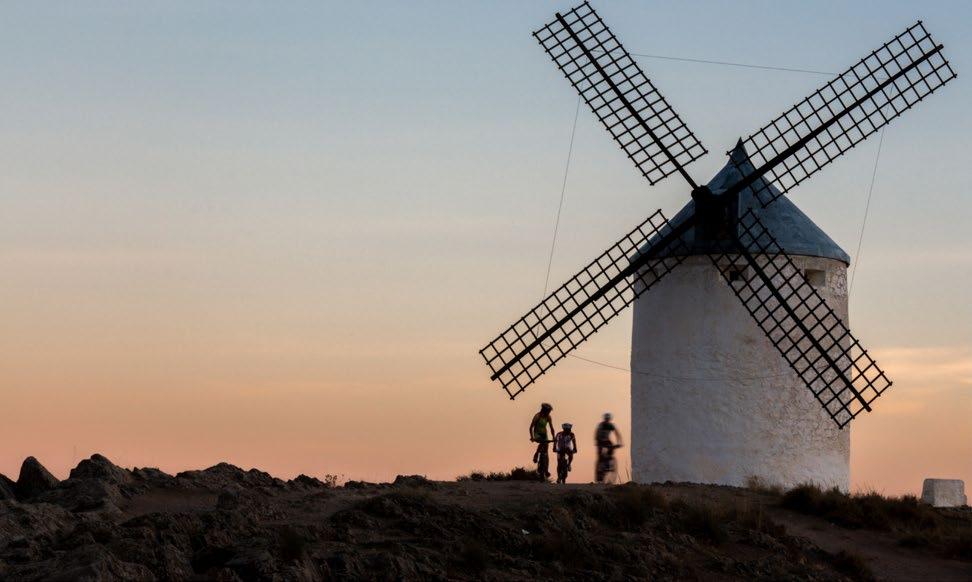
Errant. There are over 2,000 elements of cultural interest on this itinerary, which is why it has been designated a European Cultural Route. And all this while you enjoy the delicious local cuisine.
What's more, you'll be travelling through landscapes of exceptional beauty as you go past nature reserves and natural spaces such as the Ruidera Lakes and the Tablas de Daimiel.
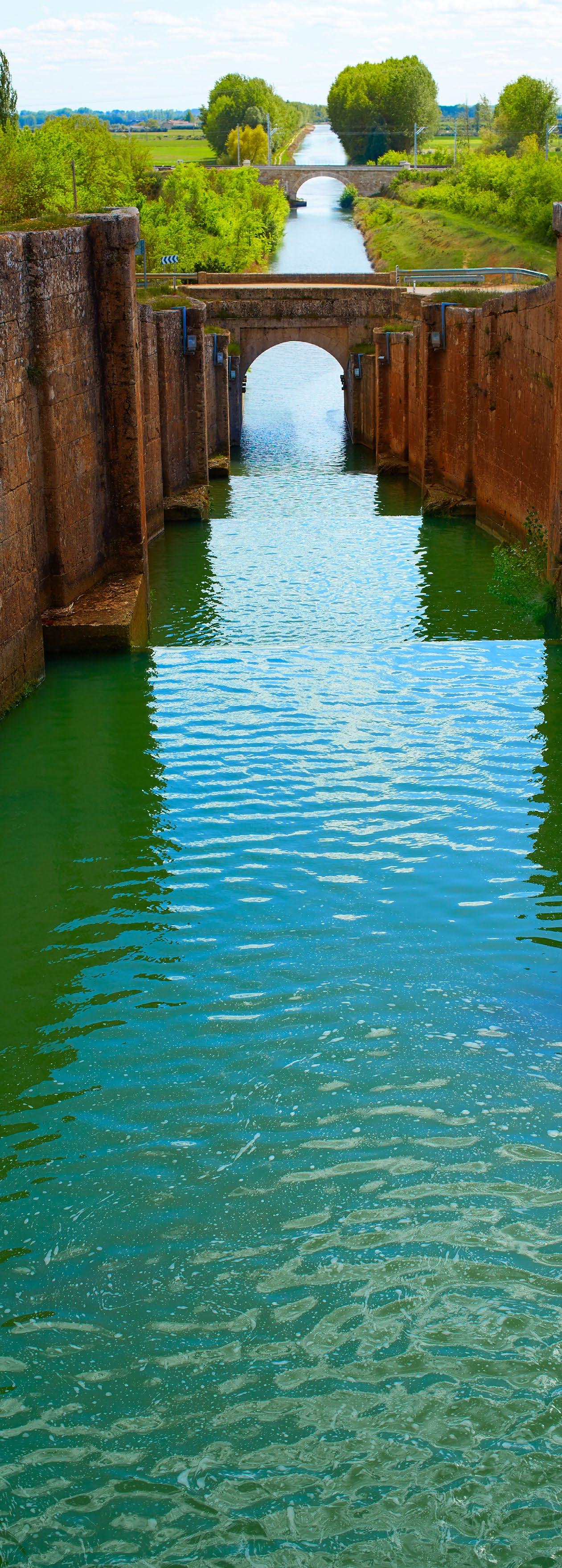
CASTILLA CANAL
Cycle along the route of the Castilla Canal, which served in the past to transport cereals from inland Spain towards the ports in the north before the arrival of the railways. This impressive work of hydraulic engineering dates from the late 18th to early 19th centuries and is currently used to irrigate farmlands.
From your bike you'll see the water flowing along this great irrigation channel with its locks, bridges, aqueducts and dams. On many of its sections you'll be surrounded by riverbank vegetation and trees that will shade you from the sun. Near the banks you'll notice that wetlands with exceptional biodiversity have formed.
You can start in Alar del Rey at the beginning of the canal in Palencia. One of the greatest draws of this 207-km route, divided into three sections, is that you travel through various attractive places in the provinces of Palencia, Burgos and Valladolid in the region of Castile-León. Explore them and discover all their history and culture. Some highlights of your route include Frómista and Herrera de Pisuerga, two treasures on the route of the Romanesque in Palencia.
You can also take a break from your bike ride and go on a river cruise.
EUROVELO ROUTES IN SPAIN
The EuroVelo (EV) project, still in development, comprises 17 itineraries based on existing routes that are attractive, have very little difference in level, and are mostly paved.
Follow one of the long-distance cycling routes that criss-cross Europe as they pass through Spain.
Three of these routes are on Spanish territory: the EuroVelo 1 (Atlantic Coastal Route), which crosses Spain from north to south, from Irún (Basque Country) to Ayamonte (Andalusia); EuroVelo 3 (the Pilgrims Route) that starts in the Navarre Pyrenees and goes as far as Santiago de Compostela, and the EuroVelo 8 (Mediterranean Route) that goes along the Mediterranean coast, from La Jonquera (Catalonia) all the way to Cadiz.
EuroVelo 1 is 1,685 km long and split into 30 stages: you can start at the Bidasoa Greenway Cycling Route. Some of its sections match EuroVelo 3 and Vía de la Plata. If you follow EuroVelo 3 along its 980 km and 21 stages, you can also discover the historic Camino de Santiago route. Enjoy the Spanish Mediterranean culture with EuroVelo 8. Its 1700 km, in 43 stages, take you to cities like Barcelona, Valencia, Malaga and Murcia.
L For more information, see www.eurovelospain.com
OTHER ROUTES
Be adventurous and try some other lesser-known routes: you have a whole range of options whether you're on a road bike or a mountain bike. Some follow the itineraries of the GR routes: these are signposted routes with a maximum length of 50 km. One example is the Cistercian Monastery Route which follows the itinerary of the GR175 in Tarragona and Lleida (Catalonia). This 108-kilometre circular route links three emblematic monasteries (Santa Creus, Poblet and Vallbona) in a beautiful natural setting.
If you want to follow the mediaeval roads used by pilgrims to reach the Guadalupe Monastery in Cáceres, you'll find 12 different routes of different lengths and levels of difficulty: these are the Roads to Guadalupe. One of them starts in Madrid, and the others in Ciudad Real, Toledo, Badajoz and in the province of Cáceres itself. You can also opt for the Route of San Vicente Mártir, more than 500 kilometres long, which starts from Huesca and links with the old Roman road Via Augusta leading to Valencia.
To criss-cross Spain from east to west, you can follow the path of the longest river on the Iberian Peninsula by cycling 1,000 km along the Tagus Nature Trail.

PRACTICAL INFORMATION
Before you choose your route, find out more about the level of difficulty and the best time of year to do it. In the colder areas in the north, it's a good idea to avoid the depths of winter (from late December to February). In the warmer regions in the centre and south of the country, many cyclists prefer to stay clear of the high temperatures in June, July and August, which are often over 35°C. Make sure you take the right clothing before you set off on your itinerary, and protect yourself from the sun.
Cyclists must ride on the hard shoulder on intercity roads. If it is impassable, you can use only the essential part of the road. As a general rule, cyclists are not allowed on motorways. On dual carriageways they can only ride on the hard shoulder provided they are over 14 and it is not specifically prohibited by the corresponding sign. It is mandatory to wear a helmet and reflective clothing at night and in tunnels. The bike's front (white) and back (red) lights must be officially approved to ensure sufficient visibility.
Cyclists must use bike lanes in cities. If there aren't any, you can cycle with care on the road. As a general rule, cyclists are not allowed on pavements or in pedestrian areas, except for in specially designated and signposted zones.

When cycle touring it is advisable to have travel insurance that includes assistance and civil liability. You can join the cycling federation in your country and ask them to extend the insurance coverage to Spain.
You'll find numerous bike hire companies in Spain. If you prefer to bring your own bike, make sure you find out your transport company's regulations and costs, whether it be a plane, train or bus. In Spain, the national railway network (RENFE) allows folded and disassembled bikes to be transported as hand luggage in some of its short and medium-distance services. Bikes can be transported without folding or disassembling on short and medium distances. You find more information on its website www. renfe.es. If you're travelling the Way of Saint James, you'll find a special service provided by Correos, the Spanish Post Office, who will send your bike.
For more information on routes, using bikes in cities, recommendations and tips, visit the tourist offices in each area and cycling federations and associations. You can also check the websites for the various autonomous regions, provinces and municipalities your route will take you through.

